HTC TP Dual Band GSM/GPRS Smartphone With Bluetooth User Manual Typhoon Feelers AWS manual book indb
HTC Corporation Dual Band GSM/GPRS Smartphone With Bluetooth Typhoon Feelers AWS manual book indb
HTC >
Contents
User Manual


Smartphone User Manual
Safeguard
Smartphone User Manual
Contents
23
Congratulations on the purchase of your new Windows Mobile™
Smartphone.
Please read before operating your device.
THE DEVICE IS NOT CHARGED WHEN YOU TAKE IT OUT
OF THE BOX.
DO NOT REMOVE THE BATTERY PACK WHEN THE DEVICE
IS CHARGING.
WHEN INSERTING YOUR SIM CARD, MAKE SURE THE
DEVICE IS POWERED OFF, AND THAT THE SIM CARD
SNAPS INTO THE SOCKET SECURELY.
YOUR WARRANTY IS INVALIDATED IF YOU OPEN OR
TAMPER WITH THE DEVICE’S OUTER CASING. (For more
information, see the enclosed warranty card)
EXPLOSIVE ATMOSPHERES
When in any area with a potentially explosive atmosphere or where
ammable materials exist, the product should be turned off and the user
should obey all signs and instructions. Sparks in such areas could cause
an explosion or re resulting in bodily injury or even death. Users are
advised not to use the equipment at refueling points such as service or
gas stations. Users are reminded of the need to observe restrictions
on the use of radio equipment in fuel depots, chemical plants or where
blasting operations are in progress. Areas with a potentially explosive
atmosphere are often, but not always, clearly marked. These include
fuelling areas, below deck on boats, fuel or chemical transfer or storage
facilities, and areas where the air contains chemicals or particles, such
as grain, dust, or metal powders.

Smartphone User Manual
Safeguard
Smartphone User Manual
Contents
23
Contents
Chapter 1 Getting Started 7
1.1 Knowing your Smartphone 8
1.2 Status indicators 13
1.3 Setting up your Smartphone 14
1.4 Accessories 18
1.5 Navigating 19
1.6 Entering text and numbers 23
1.7 Securing your Smartphone 27
Chapter 2 Using your Smartphone 29
2.1 Making a call 30
2.2 Receiving a call 33
2.3 Photo Caller ID 35
2.4 In-call options 43
2.5 Retrieving a voice mail message 44
2.6 Reviewing your calls 44
2.7 Speed Dials and Voice Tags 46
2.8 Advanced dialing information 50

Smartphone User Manual
Contents
Smartphone User Manual
Contents
4
5
Chapter 3 Using your Camera 53
3.1 Camera mode 54
3.2 Album mode 65
Chapter 4 Personalizing your
Smartphone 73
4.1 Customizing phone settings 74
Chapter 5 Getting Connected 83
5.1 Connecting to the Internet 84
5.2 Pocket Internet Explorer 87
5.3 Bluetooth 89
5.4 Modem Link 92
Chapter 6 Messaging Features 93
6.1 Setting up accounts 94
6.2 Managing accounts 96
6.3 Creating E-mail and SMS messages 97
6.4 Receiving E-mail and SMS messages 100
6.5 Viewing message folders 104
6.6 Managing messaging 106
6.7 Instant messaging 109
6.8 MMS messaging 113

Smartphone User Manual
Contents
Smartphone User Manual
Contents
4
5
Chapter 7 Synchronizing 123
7.1 Using ActiveSync 124
7.2 Installing ActiveSync 125
7.3 Server ActiveSync 126
7.4 Other information 129
Chapter 8 Applications 131
8.1 Using Contacts and Beaming 133
8.2 Using Calendar 140
8.3 Using Tasks 143
8.4 Using Voice Notes 144
8.5 Using Windows Media Player 145
8.6 Using Calculator 149
8.7 Using Java MIDlet Manager 150
8.8 Games 154
Chapter 9 Maintaining your
Smartphone 157
9.1 Adding and removing programs 158
9.2 File Manager 159
9.3 Task Manager 166
9.4 Space Maker 168

Smartphone User Manual
Contents
6
Appendix 173
Regulatory Notices 174
Troubleshooting 183
Specications 189
Index 191

Chapter 1
Getting Started
1.1 Knowing your Smartphone
1.2 Status indicators
1.3 Setting up your Smartphone
1.4 Accessories
1.5 Navigating
1.6 Entering text and numbers
1.7 Securing your Smartphone
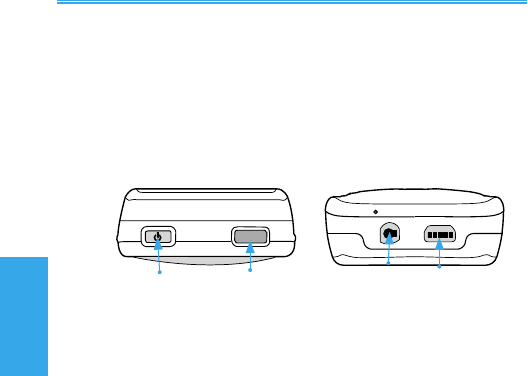
8
9
1.1 Knowing your Smartphone
This section will help you to familiarize yourself with your
Smartphone’s hardware, including a basic introduction to
the buttons and features found on the top, bottom, front,
side and rear of the phone. A brief explanation of the LED
indicator is also provided.
Top View Bottom View
1. Power button
When your Smartphone is turned Off, press and hold
the Power button to turn it On, and vice versa. When
the phone is On, you can press and quickly release the
Power button to display the Quick List, which allows you
to change proles or lock your Smartphone.
2. Infrared port
Allows your Smartphone to receive data from another
IR-compatible device through Infrared beaming.
3. Earphone plug
Plug the earphone jack here to use the handsfree mode
or listen to sound or multimedia les.
4. Mini USB connector
Attach the mini-USB cable here to synchronize certain data
in your phone with desktop or notebook PC; or to charge
its battery.
4
Smartphone User Manual
1. Getting
Started
Smartphone User Manual
1. Getting
Started
123

8
9
Front View Side View
1. LED indicator
The LED Indicator noties you of the battery and network
status of your Smartphone. The indicators are described
on the next page.
12
3
45
67
9
8
10
11
12 13
Smartphone User Manual
1. Getting
Started
Smartphone User Manual
1. Getting
Started
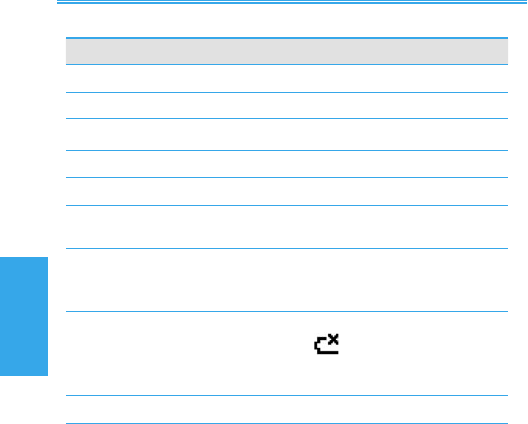
10
11
LED Indicator Status
Solid green Battery is fully charged
Blank Battery case is empty
Solid Amber Battery is charging
Flashing green Network is attached
Flashing red Battery very low (less than 4%)
Flashing blue Bluetooth set to “On” mode or “Discover-
able” mode
Flashing amber Battery temperature is hotter or colder than
the functional limits of 0 to 48 degrees Cel-
sius, and has stopped charging
Amber / green LED off Battery fault. The “Battery Fault” icon is
displayed ( ) In this case, the ashing
green LED can be recovered by unplug-
ging the AC adaptor.
Dim Network is disconnected.
2. Speaker
3. Display screen
The status indicators concerning the current mode,
battery strength, the current activity, or active program
are displayed in the Title Bar at the top of the display.
In the center of the screen is the active menu or
program (or incoming live video stream if Camera
mode is active). At the bottom of the screen are the
menus or commands related to the active program.
4. Left softkey
Performs the function shown in the “softkey label”
immediately above the button. (When in the Home
screen, pressing the Left Softkey opens the Start
Menu.)
Smartphone User Manual
1. Getting
Started
Smartphone User Manual
1. Getting
Started

10
11
5. Right softkey
Performs the function shown in the “softkey label”
immediately above the button. (In many cases,
pressing the Right softkey opens a menu dedicated
to a particular application.)
6. Home button
Press to return to the Home screen at any time.
7. Back button
Press to go back to the previous screen, or to
backspace over one character in a text eld. Press
and hold to delete the contents of an editable eld.
8. Talk button
Press to start a call or answer an incoming call. Press
and hold to turn the speakerphone mode on or off, or
switch between an active call and a call on hold.
9. End button
Press to end a call; press to return to the Home screen;
or press and hold to lock the keypad.
10. Navigation Pad / Action button
Use to scroll selection up, down, left, or right. Press
straight down on the center of the Navigation Pad
(known as the “Action” button) to select. In a text
eld, use the navigation pad to move the cursor right
or left, character by character. (See also Navigation
Pad in Section 1.5).
11. Microphone
Speak into this during a phone conversation, or when
recording a Voice Note, Voice Tag, etc.
12. Volume Up/Down button
On the left side of your Smartphone, this button lets
you adjust the volume during the talk mode. During
the standby mode, press and hold the Volume Down
button to launch the Voice Tag feature. Press and
hold the Volume Up button to launch the Voice Notes
recorder.
Smartphone User Manual
1. Getting
Started
Smartphone User Manual
1. Getting
Started

12
13
13. Camera button
On the right side of your Smartphone, this button switches
to the Camera mode, (if not already in Camera mode).
If already in Camera mode, pressing this button captures
a still image or begins capturing a video clip, depending
on the current capture submode.
Rear View
1. Car antenna connector
Allows you to attach your Smartphone to a car antenna for
better network signal reception. Simply peel off the rubber
cap and connect the antenna jack. Replug the rubber cap
if unused.
2. Camera lens
Incoming live video stream enters here and is shown on
the display screen when you are in Camera mode.
3. Self-Portrait mirror
Position the phone until the mirror reects the image you
want to capture.
4. Battery release latch
Press to release the latch to access the battery, SIM card,
or Mini-SD card. (More illustrations of this in Section
1.3).
1
23
4
Smartphone User Manual
1. Getting
Started
Smartphone User Manual
1. Getting
Started
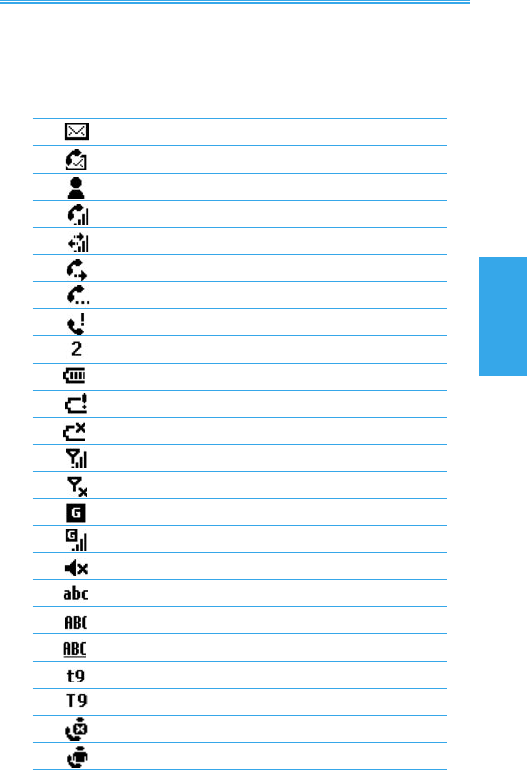
12
13
1.2 Status indicators
Status indicators are located in the Title Bar at the top of
your Smartphone’s display screen. The following table lists
common status indicators and their meanings:
New e-mail
New voice mail
New instant message
Voice call active
Data call active
Call forwarding
Call on hold
Missed call
“1” indicates Line 1; “2” indicates Line 2
Battery full
Battery very low (less than 4%)
Battery fault
Signal strength
Radio off
GPRS available
GPRS in use
Ringer off
Multipress input lower
Multipress text input mode, uppercase
Multipress text input mode, caps lock
T9 text input mode, lowercase
T9 text input mode, uppercase
Caller ID monitor is off
Caller ID monitor is running
Smartphone User Manual
1. Getting
Started
Smartphone User Manual
1. Getting
Started
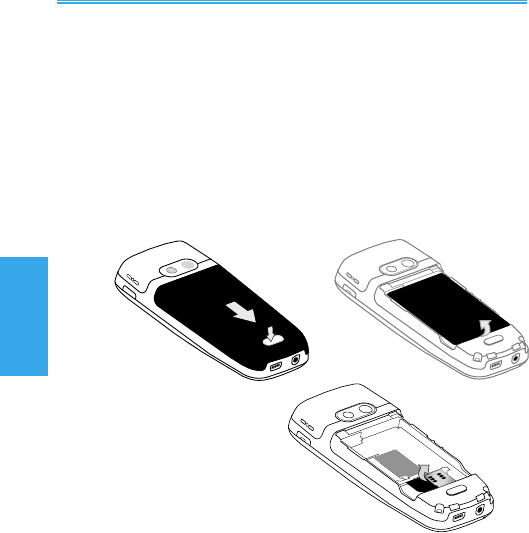
14
15
1.3 Setting up your Smartphone
In this section you will learn how to install a battery, SIM card,
Mini SD card, and how to charge the battery.
Installing the SIM Card
The SIM (Subscriber Identication Module) card contains
a computer chip that stores your personal number, phone
book, and other services provided by your cellular service
provider.
To insert a SIM card:
1. Press on the battery release latch and move the backside
cover downward to open.
2. Remove the battery by lifting it up from the bottom end.
3. Pry the SIM metal socket open.
4. Insert the SIM card with the gold-plated contact area on
the card facing down. Push the metal socket down to lock
into place.
Smartphone User Manual
1. Getting
Started
Smartphone User Manual
1. Getting
Started

14
15
Installing the Mini SD card
Use only the Mini SD (Secure Digital) card in your Smart-
phone. You can install the Mini SD card to store images,
video clips, music and other data on your phone.
To insert a Mini SD card:
1. Remove the back phone cover as shown on the previous
page.
2. Slide the Mini SD card into the holder, with the gold-plated
contact area facing down.
3. Push the card down and pull up the metal latch to secure
it into place.
Charging the battery
Your Smartphone is powered by a rechargeable Lithium-
Ion battery. The battery will eventually wear out after a few
hundred charges or discharges. Replace the battery through
an authorized vendor when the operating time is noticeably
shorter than usual.
NOTE: Please note that the time it takes for a battery to fully
charge depends on the environment temperature at the time
of charge; a completed charge normally takes about 3.5-4
hours under 0-10 degree temperatures, and below 3 hours
for temperatures ranging from 20-45 degrees.
Mode Estimated battery life
Talk time 3.5 to 4 hours
GPRS 2 hours prox.
Standby 140 hours
Smartphone User Manual
1. Getting
Started
Smartphone User Manual
1. Getting
Started

16
17
Charge the new battery before using your Smartphone for
the rst time. When the low-battery indicator appears, save
any unsaved data you are working on by synchronizing your
phone with your PC or a Microsoft Exchange Server. Do not
restart your Smartphone until you have connected it to an
external power source.
NOTE: Do not leave your Smartphone connected to a
charger for longer than a week because overcharging can
shorten a battery’s lifespan. Your battery will automatically
discharge when the device is not in use. Leaving the battery
in extremely hot or cold places may also reduce its capacity
or shorten its lifespan.
Smartphone User Manual
1. Getting
Started
Smartphone User Manual
1. Getting
Started

16
17
To charge your battery:
Your Smartphone can be charged while switched on or off.
Charge your battery by plugging the power cable into the
mini USB connector at the base of the phone, or by using
the AC adaptor.
If your Smartphone is turned off, charging is indicated by an
amber light. If it is turned on, charging is indicated by the
solid amber light on the LED indicator and the charging icon.
The completed charge is indicated by either a green light or
a charged icon. You can also charge your phone using the
USB Sync cable while connected to the PC’s USB port.
Battery Capacity Indicator
Full
50%-74% capacity
28%-49% capacity
Less than 27% capacity
Very Low alert (less than 4%)
Smartphone User Manual
1. Getting
Started
Smartphone User Manual
1. Getting
Started

18
19
1.4 Accessories
Mini USB cable
A USB cable is provided to allow you to synchronize infor-
mation between your phone and a desktop or notebook PC
using Microsoft ActiveSync. You can also charge the phone’s
battery by plugging the cable to a PC USB port.
Stereo earphones with handsfree
function
Use the earphones to listen to sound or multimedia les. The
earphones can also function as a handsfree device.
Using the earphones
Connect the earphones cable to the earphones jack located
at the base of the phone. Press the “Press To Talk” button
to receive an incoming call. Press and hold it to end a call.
Rotate the Volume buttons to adjust the sound level.
Smartphone User Manual
1. Getting
Started
Smartphone User Manual
1. Getting
Started

18
19
1.5 Navigating
This section discusses how to navigate through your
Smartphone’s screens in order to perform tasks quickly
and easily.
Navigation Pad
The Navigation Pad was identied as item #10 in the illustra-
tion on page 9. It provides an easy way to move/scroll the
selection focus on the screen.
• Press the left side of the Navigation Pad to move left.
• Press the right side of the Navigation Pad to move right.
• Press the top of the Navigation Pad to move up.
• Press the bottom of the Navigation Pad to move down.
Action button:
• Select a highlighted item by pressing straight down on
the center of the Navigation Pad, which is also known as
the Action button. In many cases, scrolling to an item
and pressing the Action button executes a command, or
takes you to a program or setting. When you scroll to a
checkbox, pressing the Action button selects or clears the
box.
Softkeys
There are two softkeys on your Smartphone, located directly
below the display screen (“Left Softkey” and “Right Softkey”).
Each softkey performs the command displayed immediately
above it on the screen (called the “Softkey label”), making
it easy to navigate around your Smartphone and to perform
common commands.
Smartphone User Manual
1. Getting
Started
Smartphone User Manual
1. Getting
Started

20
21
Menus
On many screens, the function of the Right Softkey is to open
a menu which displays a list of options that are relevant to
the current screen/application. Selecting a menu option will
either perform that command or take you to another part of
the user interface where you can perform the command.
To select a command:
Press the Up or Down navigational button until the command
you want is highlighted, then press the Action button. Or:
You can choose menu commands quickly by pressing the
number on the keypad that corresponds to the number shown
to the left of the command you want, when the menu is open.
Each command has a number. Or:
For some commands, there is also a shortcut key that can
be pressed when the menu is not open. Those shortcuts are
shown to the right of the command on the menu.
Smartphone User Manual
1. Getting
Started
Smartphone User Manual
1. Getting
Started

20
21
The Home button
Pressing the Home button takes you to the Home screen,
which is your starting place for most tasks. You can gain
access to all of your Smartphone’s features and programs
from the Home screen.
The top of the Home screen displays icons for the ve ap-
plications that were recently accessed. The center of the
Home screen displays upcoming appointments, the number
of text messages in the inbox, and your current prole. To
open an application, scroll to one of these items and press
the Action button on the Navigation Pad.
The Home screen is the default display when you turn on
your Smartphone. You can also access the screen anytime
by pressing the Home button.
The Back button
Pressing the Back button takes you to the previous screen,
in a similar manner to the Back button on an Internet browser.
In a text eld, pressing the Back key moves the cursor back
to delete one or more characters. This is similar to pressing
the Backspace key on a keyboard.
Smartphone User Manual
1. Getting
Started
Smartphone User Manual
1. Getting
Started

22
23
The Start menu
Your Smartphone comes with many bundled programs
that you can start using immediately. To install additional
programs on your Smartphone, refer to the Companion CD
that came with your phone.
To use the Start menu:
1. When in the Home screen, press the Left Softkey (beneath
the word Start).
2. Select a program by scrolling to it and pressing the Action
button. You can also select the program by pressing the
corresponding number on the menu, when the menu is
open.
The Quick List
The Quick List offers a list of functions, such as locking your
phone, locking the phone's keypad, and turning on the Flight
mode, as well as the list of available prole types.
To use the Quick List:
1. Press and quickly release the Power button on top of the
Smartphone to display the Quick List. (Caution: If you
press and hold too long, the device will power off.)
2. Select the item you want by scrolling to it and pressing the
Action button or the related number.
Smartphone User Manual
1. Getting
Started
Smartphone User Manual
1. Getting
Started

22
23
1.6 Entering text and numbers
Your Smartphone supports three input modes for entering text
and numbers: Multipress, T9, and Numeric. The Multipress
and T9 modes are used for entering text, and the Numeric
mode is for entering numbers. When you select a eld that
requires text or numeric entry, your Smartphone will automat-
ically select the appropriate input mode. When the cursor
is in a eld which requires text or number input, you can
switch input modes yourself by holding down the asterisk
(*) key to pop up the menu. Commands on the menu are
Symbols, 123, Abc, and T9 English. One of the following
status indicators will display in the Title Bar to show which
input mode is currently active:
Multipress mode
When you are in Multipress mode, you can enter a letter by
pressing the number key on which the letter appears. To
enter the rst letter on the number key, press the key once,
to enter the second letter, press the key twice quickly, and
so on. The letter entered most recently is underlined until
you have completed the keypresses for the letter and moved
on to the next letter.
For example: To enter the word "hat," press 44, 2, 8.
Indicator Mode
abc
Abc
ABC
t9
T9
T9
123
Multipress text input mode, lowercase
Multipress text input mode, uppercase
Multipress text input mode, caps lock
T9 text input mode, lowercase
T9 text input mode, uppercase
T9 text input mode, caps lock
Numeric input mode
Smartphone User Manual
1. Getting
Started
Smartphone User Manual
1. Getting
Started
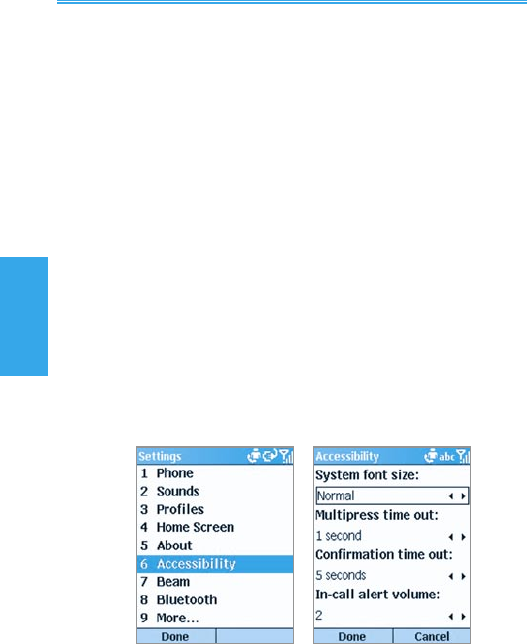
24
25
When you enter letters that are on the same number key,
you must pause after entering the rst letter and wait until
the underline disappears before entering the next letter so
your Smartphone can process the rst letter. This pause is
called the Multipress time-out, and you can adjust the length
of the pause between keypresses.
For example: To enter the word "cat," press 222, pause,
press 2, and then press 8. Press the # key to move a
space.
To enter punctuation in Multipress mode, press 1 repeatedly
until you see the punctuation mark that you want.
To change the Multipress time-out:
1. Select Settings from the Start menu.
2. Select Accessibility.
3. In the Multipress time-out eld, select the length of the
pause between keypresses that you prefer.
Smartphone User Manual
1. Getting
Started
Smartphone User Manual
1. Getting
Started

24
25
T9 mode
When you are in the T9 mode, just press the number keys
that contain the letters that you want to form a word. T9
will then analyze your keypresses and attempt to complete
the word.
For example: To enter the word "shoe," press 7, 4, 6, 3.
To enter text in T9 mode:
1. Press and hold the * key until the input menu appears.
Scroll down and choose “English.” The t9 indicator should
appear at the top of the display.
2. Enter letters by pressing the keys on which the letters
appear. Press a key only once for each letter.
3. Press the # key to accept the word and enter a space
after it, or press the Down button on the Navigation Pad
to scroll through the available words; press the Action
button to accept the word choice.
4. Press 1 and then press the Up or Down button on the
Navigation Pad to cycle through common punctuation
symbols.
NOTE: T9 cannot always nd the word you want in the T9
dictionary. In these cases, switch to Multipress mode. After
you have entered the word in Multipress mode, the word will
be added to the T9 dictionary.
Numeric mode
When you are in the Numeric mode, just press the number(s)
you want to enter on the keypad. If a eld permits a nu-
merical entry only, such as the Work phone number eld
in Contacts, the input mode will automatically default to
Numeric mode.
Smartphone User Manual
1. Getting
Started
Smartphone User Manual
1. Getting
Started

26
27
Miscellaneous input tasks
• To enter a space: In Multipress or T9 mode, press the
# key.
• To start a new line: Press the Action button.
• To switch between uppercase, lowercase, and caps
lock: Press the * key.
• To enter a symbol: Press and hold the # key, select the
symbol you want, and then press the Done softkey.
• To enter a number, an asterisk (*), or a pound sign (#):
Press and hold the * button on your Smartphone’s keypad
to pop up a selection list, then select “123” for Numeric
mode. You can then press the desired corresponding key
on the keypad.
• To delete characters: Press the Back button to
backspace over a single character. Press and hold the
Back button to backspace and delete all text in a eld.
• To enter the plus (+) sign for international calls: Press
and hold 0.
Smartphone User Manual
1. Getting
Started
Smartphone User Manual
1. Getting
Started

26
27
1.7 Securing your Smartphone
You can customize the level of security you want to have on
your Smartphone by locking the SIM card, the keypad, or
the entire phone.
Locking the keypad
The keypad lock turns off the keypad functionality. This is
a helpful feature if, for example, your Smartphone is turned
on and in your pocket, and you want to prevent accidental
keypresses from dialing a number, etc.
• To lock your keypad: In the Home screen, press and
hold the End button. The Left softkey will display Unlock,
indicating that your Smartphone is locked.
• To unlock your keypad: In the Home screen, press the
Unlock softkey, and press the # key.
Locking the SIM card
Locking your SIM (Subscriber Identity Module) card prevents
you from using the phone, but you can still turn it on and make
emergency calls. When you turn your Smartphone on, you
will be prompted for your PIN1 password, which you must
enter correctly before you can use your phone.
• To lock the SIM: In the Home screen, press the Start
softkey, select Settings, select Security, select Enable
SIM Lock, and then press the Action button. Enter your
PIN1 password, and then press the Done softkey.
• To unlock the SIM: In the Home screen, press the Start
softkey, select Settings, select Security, select Disable
SIM Lock, and then press the Action button. Enter your
PIN1 password, and then press the Done softkey.
Smartphone User Manual
1. Getting
Started
Smartphone User Manual
1. Getting
Started

28
Locking your Smartphone
Locking your Smartphone prevents access to personal data.
When you enable this feature, your phone will automatically
lock after a specied time of inactivity. A screen will be dis-
played requiring your phone lock password before access
is granted. You can still receive calls and make emergency
calls, even when the Smartphone is locked.
• To lock your Smartphone:
1. Press the Power button and quickly release, to display
the Quick List. Select Device lock, then press the OK
softkey.
2. In the Lock phone after eld, select the amount of
time you want your Smartphone to be inactive before
it automatically locks.
3. In the Password eld, enter the password you want
to use, to access your phone when it is locked.
4. In the Conrm password eld, enter the password
again, then press the Done soft key.
• To unlock your Smartphone: Press the Unlock softkey,
enter your password, and then press the Unlock softkey
again.
• To turn off phone lock: Select Settings > Security
> Disable Phone Lock, enter your password, and then
press the Done softkey.
NOTE: If you forget your password, there is a way to re-gain
access to your Smartphone, but you will lose all programs
you installed. First, turn off your phone. Then press and
hold down the Left Softkey (“Softkey 1”), the Right Softkey
(“Softkey 2”), and the Power button, all at the same time.
Continue to hold them down until a message appears and
asks you if want to clear the memory. If you select Yes,
all programs you installed yourself will be lost, but you will
regain control of your Smartphone. (If you had previously
synchronized with a PC, you can then get the lost programs
back easily by synchronizing with it again.)
Smartphone User Manual
1. Getting
Started

Chapter 2
Using your
Smartphone
2.1 Making a call
2.2 Receiving a call
2.3 Photo Contacts (Caller ID)
2.4 In-call options
2.5 Retrieving a voice mail message
2.6 Reviewing your calls
2.7 Speed Dials and Voice Tags
2.8 Additional dialing information

Smartphone User Manual
2. Using
your phone
Smartphone User Manual
2. Using
your phone
30
31
2.1 Making a call
There are several ways to make a call.
Making a call from the Home screen
When in the Home screen, press the numbers on the keypad
to enter the phone number, and then press the Talk button
to make the call. Press the Back button if you need to
backspace over a digit.
As you enter a phone number, your phone searches Con-
tacts, Call History, Speed Dial lists, and your SIM card, to
nd a matching number. Matching names and numbers will
be displayed. When you see the name of the person you
want to call (or the entire number) displayed, select it and
press the Talk button.
In this example, the rst few digits of a phone number have
been entered. The names listed in this screen have all been
found to have phone numbers that start with these digits. At
this point, you can select the desired name without having
to enter more numbers.

Smartphone User Manual
2. Using
your phone
Smartphone User Manual
2. Using
your phone
30
31
Making a call from Contacts
To make a call by Contact name:
In the Home screen, press the Right Softkey ("Contacts") or
select Contacts from the Start Menu. If there are many con-
tacts listed, you can enter the rst few letters of the desired
contact's name to perform a search. Select the name you
want to call and press the Talk button. The phone number
that has been specied as the default phone number for that
contact entry will be dialed.
To change the default number for a Contact:
In the Home screen, press the Right Softkey ("Contacts")
or select Contacts from the Start Menu. Select the contact
whose default phone number you want to change, then
press the Right or Left navigational button to change the
default number. The abbreviation at the right side of the list
indicates the default number. For example, if you change
“w” to “m,” the default number changes from Work phone
(w) to Mobile phone (m).
To make a call from an open Contact card:
In the Home screen, press the Right Softkey ("Contacts")
or select Contacts from the Start Menu. Select the desired
contact, then press the Action button to display all the infor-
mation for that contact. Select the number you want to call,
then press the Talk button.
NOTE: For more information about Contact list abbrevia-
tions and Contact cards, please see Chapter 8.

Smartphone User Manual
2. Using
your phone
Smartphone User Manual
2. Using
your phone
32
33
Making a call using a recently dialed
number
When in the Home screen, press the Talk button to display
a list of recently-dialed names/numbers. Select the item
you want to dial, then press the Talk button again. Note that
you can also use the menu in this screen to open a Call Info
screen for the selected item.
Making a call from the Call History list
Select Call History from the Start Menu. Select the number
or name you want to call, then press the Talk button.
Making a call from a hyperlink
When you see an underlined phone number presented as
a hyperlink in an E-mail message, just scroll to it, and press
the Action button to make the call.
Making emergency calls
Calls to emergency service numbers can be made under
any circumstances, even if you have locked the SIM card
and/or your phone.
To place an emergency call: Dial the emergency number
appropriate for your location, and press the Talk button.

Smartphone User Manual
2. Using
your phone
Smartphone User Manual
2. Using
your phone
32
33
2.2 Receiving a call
When you receive a call, the name and number of the caller
are displayed on the screen. If the name of the caller is not
in your Contacts list, only the caller's phone number is dis-
played. You can answer a call by pressing the Talk button
or the Left softkey (“Accept”).
If don't want to take the call, press the Right softkey (“Re-
ject”). Note that selecting Reject will connect the caller to
your voice mail box, if you subscribe to this service.
NOTE: This is the default behavior for incoming calls. See
the next section if you want a Photo ID (which you have
associated with the caller) to be displayed on your screen
during incoming calls.

Smartphone User Manual
2. Using
your phone
Smartphone User Manual
2. Using
your phone
34
35
Answering a second call using Call
Waiting
If you are already talking on the phone when you receive
another call, the Call Waiting screen will appear. To place the
current call on hold and answer the incoming call, press the
Left Softkey (“Accept”) or the Talk button to simultaneously
place the rst call on hold and answer the second call.
If you want to end the rst call before answering the incoming
call, press the End button, and then press the Accept soft
key or the Talk button to accept the incoming call.
Rejecting a Call Waiting call
If you are already talking on the phone when you receive
another call and you don't want to answer the incoming
call, press the Right Softkey (“Reject”) in the Call Waiting
screen. This will keep your current call in progress, but will
connect the “call waiting” caller to your voice mail box, if you
subscribe to this service.

Smartphone User Manual
2. Using
your phone
Smartphone User Manual
2. Using
your phone
34
35
2.3 Photo Contacts (Caller ID)
Photo Contacts is a “Caller ID” application that adds more
fun to using your phone. It allows you to assign photos or
animated GIF les to the entries in your Contacts. Then
when a person calls you (for whom you have previously
assigned a photo ID in Contacts), that photo ID will appear
on your phone’s incoming call screen.
You can also perform maintenance on the Contacts, even
create new Contacts and Groups and assign members to
the Groups, right from within Caller ID. (See also Chapter
8 for information about maintaining Contacts.)
The Caller ID utility does not run automatically when you
turn on your phone. You must invoke it after the phone is
turned on.
Starting the Photo Caller ID program
Select Photo Contacts from the Start Menu to invoke the
Caller ID program. If you have many Contacts, it may take
a few moments to load them. After they are loaded, the icon
shown below will display in the Title Bar. It indicates that the
“Caller ID monitor” is running, and Photo IDs (if assigned)
will display when incoming calls are received. (Section 1.2
of Chapter 1 illustrates the Photo Caller ID monitor “On”
and “Off” icons.)
NOTE: Even if Photo Caller ID is not running, you can still
use Caller ID to assign photos and manage contacts and
groups. The photos will display within your Contacts applica-
tion, but incoming calls will not be able to display the Photo
IDs you assigned. (To disable Photo Caller ID manually, use
Options > General as mentioned later in this section.)

Smartphone User Manual
2. Using
your phone
Smartphone User Manual
2. Using
your phone
36
37
Main List View and Detailed View
When you start the Caller ID application, the main List View
will display as shown in the example below on the left. The
Contacts entries fully mirror those in your Pocket Contacts
(Chapter 8). Any changes you make to your Contacts data
using Caller ID will simultaneously be made in your Pocket
Contacts. In the example below, a Photo ID has already
been assigned to the selected Contact entry. The icon at
the rightmost side of each Contact indicates whether the
Contact resides in your phone’s local memory or on the SIM
card. If a Photo ID has been assigned, an additional icon
will indicate such.
Main (List) View Detailed View
To switch to Detailed View, press the Action button. All data
that has been entered for the selected Contact will be listed.
To switch back to List View, select Cancel from the menu.

Smartphone User Manual
2. Using
your phone
Smartphone User Manual
2. Using
your phone
36
37
Menu Commands
The menu in Detailed View lets you display the Next or
Previous contact entry; Edit or Delete the current contact,
and Assign or Unassign a photo ID to it.
The menu in the main List View contains the following
commands:
New
Opens a standard screen in which you can enter data and
create a new entry in your Pocket Contacts.
Delete
Select the entry you want to delete, then select Delete. A
message will remind you that if you delete this entry us-
ing Caller ID, it will also be deleted in your Smartphone’s
Contacts.
Reset Filter
This command is enabled after you have performed any
manual ltering of entries using your Smartphone’s keypad.
For example, if you have pressed the keys for “j,” “a,” “c,”
and “k” to list only the entries containing the string “jack,”
you can select Reset Filter, or press the * shortcut key, to
reset the main view so that all entries are once again listed.
(NOTE: This command does not affect any ltering you
may have done using the Filter command explained on
the next page.)
Manage Group
This command provides a convenient interface that lets you
perform complete management of your contacts groups.
Initially, it opens the Manage Group screen, which lists all
currently existing groups and the number of members as-
signed to each group, as well as the Photo ID assigned to
the selected group (if any).

Smartphone User Manual
2. Using
your phone
Smartphone User Manual
2. Using
your phone
38
39
Press the Right Softkey in the Manage Group screen to open
the menu, which lets you create New groups, Rename or
Delete groups, Assign Members to groups, Assign Photo
or Unassign Photo, and Preview the behavior of an already-
assigned photo and/or template.
The Assign Photo, Unassign Photo, and Preview com-
mands in the Manage Group screen operate the same as
those for assigning individual Photo IDs, as explained later
in “Assigning a Photo ID to a Contact.” Note that a Photo
ID assigned to a group will display during an incoming call
only if no individual Photo ID has been assigned to the caller.
The individually-assigned Photo ID has precedence over the
group-assigned Photo ID.
Filter
This command opens a submenu that lets you control which
category of items are listed on the screen: SIM Only, Con-
tacts Only, and Group. By default, No Filter is active.
Assign Photo
Explained later in “Assigning a Photo ID to a Contact.”
Preview
This command is available if a Photo ID is currently assigned
to the selected Contact entry. First, select a Contact entry in
the list that already has a photo assigned to it. Then select
Preview, or press the # button on your phone keypad.
Options
Selecting Options opens a submenu that contains three
commands: Set Default Photos, Display Settings, and
General.
Set Default Photos — Opens a screen that lets you assign,
change, or unassign default Photo IDs for Unknown Photo,
Not-found Photo, and general Default Photo, as follows:

Smartphone User Manual
2. Using
your phone
Smartphone User Manual
2. Using
your phone
38
39
Unknown Photo: This photo will display whenever the phone
number of the incoming call is not known to Caller ID because
no phone number was “passed in” to your Smartphone. This
would occur if the person calling you has blocked their phone
number from being displayed to the receiver, or has not
enabled the broadcast of their Caller ID.
Not-found Photo: This option in the Set Default Photos
screen lets you assign a generic Photo ID to any incom-
ing call from a person whose number is not found in your
Contacts. That is, the phone number of the incoming call is
known, but has no matching entry in your Contacts.
Default Photo: This photo will display when the incoming
call is found to be from a matching entry in your Contacts
database, but so far there is no user-assigned Photo ID
for either that individual Contact entry, or for the Group it
belongs to.
Display Settings — Selecting this from the Options sub-
menu opens the Display Settings screen, which allows you to
specify whether the Photo ID should consist of only a photo
(Use Photo Only), or a photo merged with a template (Use
Template). Options available in this screen will depend on
which of these is active in the Display Style eld.
General — Opens a screen that contains two options:
Storage Path for Re-sized Photos: Every time you
use Assign Photo to assign a photo, Caller ID will
automatically copy and re-size the original photo le.
You can then delete the original le, if you wish to save
valuable storage space in the phone. The Storage Path
for Resized Photos eld allows you to specify whether
you want these re-sized photos to be saved to your
Smartphone or to your Storage Card.
Display Photo During Incoming or Waiting Call:
Active by default. If you uncheck this checkbox and then
select Done, your Smartphone will recover its original
background image for incoming calls.

Smartphone User Manual
2. Using
your phone
Smartphone User Manual
2. Using
your phone
40
41
Assigning a Photo ID to a Contact
The Assign Photo command lets you assign an image le
or animated GIF le (“Photo ID”) to an individual Contact
entry stored in your Pocket Contacts, or Phonebook entry
on the SIM card. You can also specify a size, and a position
for the Photo ID.
And, to add more fun and a stronger visual impact to your
incoming calls, you can assign an animated “template ID,”
which will serve as a frame around the image, if desired.
Templates are animated GIF les, and are available in both
Portrait and Landscape orientation. You can choose to
display the Photo ID only, or the Photo ID together with a
template ID, and easily change Photo IDs and/or Template
IDs at any time. A collection of templates are included in
the \\Storage\My Documents\IA Caller ID Photos folder
of your Smartphone.
NOTE: The steps in this section are for the Assign Photo
command on the main menu (individual Contact assign-
ment), but this same basic procedure can also be followed
when:
• Assigning a Photo ID to a Group (using the Assign Photo
command on the menu in the Manage Group screen)
• Assigning “Unknown Photo,” “Not-found Photo,” and
“Default Photo” (using the Assign Photo command on
the menu in the Set Default Photos screen)
• Assigning an individual Photo ID using the Assign Photo
command on the menu accessed when in Detailed View
First, make sure the photo you want to use is either a JPEG,
BMP, or GIF le (either still or animated GIF). By default, the
\\Storage\My Documents folder is searched for these le
types. If the le you want to use is located somewhere else,
you can optionally search other folders in Step 2 below.

Smartphone User Manual
2. Using
your phone
Smartphone User Manual
2. Using
your phone
40
41
1. In the main Caller ID screen, select the desired Contact
in the list.
2. Select Assign Photo from the menu, or simply press the
Left Softkey. The rst Assign Photo screen will appear.
In it, your JPEG, BMP, and GIF les will be displayed as
thumbnails.
Optional: Or, you can use your phone’s camera to take a
new picture and then assign it as a Photo ID. Open the menu
in this Assign Photo screen and select New from Camera.
This switches to Camera mode so you can take a new photo.
After taking a new photo, you will be returned to Caller ID so
you can assign the new photo as a Photo ID.
3. Select the le you want to use as the Photo ID.
4. Press the Left Softkey (“Next”). A Preview screen
opens.

Smartphone User Manual
2. Using
your phone
Smartphone User Manual
2. Using
your phone
42
43
If Use Template is active in the Display Settings screen, the
photo is previewed in a template when you press “Next.” An
example is shown below in the gure on the right. You can
use the menu in this Preview screen to preview the Next
Template or Previous Template, or press the Right or Left
navigational buttons.
If Use Photo Only happens to be active in the Display Set-
tings screen, the photo alone is previewed with a pre-set
sample name and phone number, according to the current
Position setting in Display Settings. An example is shown
on the left below.
5. If this Preview screen already shows the setup you want,
press the Left Softkey (“Done”).
Or, to access various setup options, press the Right
Softkey to open the menu.

Smartphone User Manual
2. Using
your phone
Smartphone User Manual
2. Using
your phone
42
43
Select Display Settings from the menu if you want to switch
to either Photo Only assignment or Use Template assign-
ment. If you choose Photo Only, you can specify one of
several positions, and a size. If you choose Use Template,
you can specify the template to be used, and the method for
tting the photo on the Incoming Call screen.
You can also open the Display Settings screen outside of
the “Assign Photo” process by selecting Options > Dis-
play Settings from the main menu in List View, and you
can preview the behavior of any Photo ID assignment by
selecting Preview.
2.4 In-call options
Listed below are all the menu options that might possibly be
available when a call is in progress. Some of these options
are only available when multiple calls are in progress or
during a conference call.
End — Disconnect the call.
Hold — Place the active call on hold.
Unhold — Activate the call on hold.
Swap — Switch between two calls.
Save Contacts — Create a Contact record for the caller.
Conference — Join together all existing calls, if you have
subscribed to this service.
Private — Break one call out of a conference and makes this
call active while the rest of the conference is on hold.
Speakerphone — Increase the volume of the earphone.
Mute — Mute the microphone for the active call. The other
party will not hear anything you say, but you can still hear
the other party.
Unmute — Turn the microphone back on for the active
call.

Smartphone User Manual
2. Using
your phone
Smartphone User Manual
2. Using
your phone
44
45
2.5
Retrieving a voice mail message
When in the Home screen, press and hold 1 (varies with
operator) to call your voice mailbox, and follow the prompts
to retrieve your messages.
NOTE: This is actually a Speed Dial (see section 2.7).
Speed Dial 1 is reserved for voice mail access and the
number is congured in your settings.
2.6 Reviewing your calls
Using Call History and Call Timers, you can view infor-
mation about phone calls that you have made and received.
For example, you can see who has called you recently and
nd out how much time you have spent talking on your
Smartphone.
Call History
Call History displays the last 36 calls that you have made,
received, and missed. Each entry in Call History contains
the start time of the call, the duration, the caller's name,
if available, and the caller's number. The oldest calls are
automatically deleted from the list to make room for the
newest calls.
To view your Call History, select Call History from the
Start menu. If desired, you can then lter the list so that
only Missed Calls, Incoming Calls, or Outgoing Calls are
listed. Simply open the menu in the Call History screen,
select Filter, and then select the desired category from the
submenu.

Smartphone User Manual
2. Using
your phone
Smartphone User Manual
2. Using
your phone
44
45
Other commands on the menu in the Call History screen
besides Filter:
Find Contact — Lets you view Contact information related
to the selected entry.
E-mail — Select the entry in the Call History list to whom
you want to send E-mail, then select E-mail on the menu.
You will be switched to the Messaging screen.
View Timers — Opens the Call Timers screen. See the
subsection below for details.
Delete — Removes the selected item from the list.
Delete List — Removes all items in Call History.
Save to Contacts — Creates a new Contact entry using the
info related to the selected item in Call History.
Call Timers
Call Timers gives you detailed information regarding the
length of your last call, the total number of calls made and
received, calls by type (incoming, outgoing, roaming, and
data), and a lifetime counter.
Call Timers is useful for keeping track of your calling patterns,
for example to determine what type of calling plan you want.
It can also help you estimate your monthly billing. You can
reset Call Timers to zero (0), for example to start timing calls
for a new monthly billing cycle.
To access the Call Timers screen, select Call History from
the Start menu, then open the menu in the Call History screen
and select View Timers.

Smartphone User Manual
2. Using
your phone
Smartphone User Manual
2. Using
your phone
46
47
2.7 Speed Dials and Voice Tags
You can create “Speed Dials” for frequently-called phone
numbers by simply pressing and holding one or two keys.
You may choose Speed Dial entries from 2-99; Speed Dial
1 is reserved for voice mail access and the number is con-
gured in your settings.
You can create a Speed Dial for a phone number, a program
on the Start menu, an E-mail address, or Web page address
(URL) that is stored in Contacts.
Speed Dials
Creating a Speed Dial for a phone number:
1. In the Home screen, press the Right Softkey (“Contacts”),
or select Contacts from the Start menu.
2. Select the desired Contact entry and then press the Action
button to access the Contact card. All data entered for
that Contact will be listed.
3. Select the phone number for which you want to assign a
Speed Dial.
4. Press the Right Softkey to open the menu and select Add
Speed Dial.
5. In the Keypad Assignment eld of the Add Speed Dial
screen, select the number you want to assign as the Speed
Dial. Press the Left or Right navigational button to select,
or press the Action button to view the full list of choices.
6. Press the Left Softkey (“Done”) to save the new Speed
Dial.

Smartphone User Manual
2. Using
your phone
Smartphone User Manual
2. Using
your phone
46
47
For URLs and E-mail addresses:
You can also create Speed Dials for URLs (Web addresses)
and E-mail addresses that are stored in Contacts. In Step 3
above, just select the desired E-Mail address or URL address
(instead of a phone number).
Making a call using a Speed Dial:
When in the Home screen, press and hold the number on the
keypad that you have assigned as a Speed Dial for a number.
If the Speed Dial number consists of two digits, press the rst
digit and then press and hold the second digit.
Viewing Speed Dials you have created:
In the Home screen, select Speed Dial from the Start menu.
All Speed Dial entries will be listed. In addition, you can use
the menu in this screen to perform the following:
Run — Invoke the contact method associated with the
selected Speed Dial (dials a number, starts Internet Explorer,
or invokes Messaging). You can perform this same function
by pressing the Left Softkey (“Go”).
Find Contact — Open the Contact card associated with the
selected Speed Dial.
Delete — Delete the selected Speed Dial entry from the
list.
Filter — Lets you lter the list.

Smartphone User Manual
2. Using
your phone
Smartphone User Manual
2. Using
your phone
48
49
Voice Tags
You can record a voice tag for a phone number, E-mail ad-
dress, or Web page address that is stored in your Contacts.
Then, when you verbally speak the voice tag, your Smart-
phone automatically dials the associated phone number,
opens an E-mail message using the associated address,
or goes to the associated Web page.
Creating a Voice Tag for a phone number, E-mail ad-
dress, or URL in your Contacts:
1. In the Home screen, press the Right Softkey (“Contacts”)
or select Contacts from the Start menu.
2. Select the desired Contact entry, then press the Action
button to access the related Contact card. All data entered
for that Contact will be listed.
3. Select the phone number, E-mail address, or Web page
address for which you want to assign a Voice Tag.
4. Press the Right Softkey to open the menu, and select Add
Voice Tag.
5. After the message/beep, begin recording the voice tag
(preferably one easy-to-recognize word).
6. Your SDA will automatically play back the voice tag. If
successful, a message will indicate such. Select OK to
close the message screen.
7. The Add Speed Dial screen will display. It displays,
and allows you to edit, the Name, Value, and Keypad
Assignment. Press the Left Softkey (“Done”) when ready
to save the new voice tag.
To use the voice tag, press and hold the Volume Down button
on the left side of the phone for three seconds in the Home
screen, to invoke the recording function. Say the word that
you recorded as a voice tag. The phone plays back the voice
tag and then dials the associated phone number; or opens a
new E-mail message; or goes to the associated Web page
(whichever you chose prior to creating it in Step 3 above).

Smartphone User Manual
2. Using
your phone
Smartphone User Manual
2. Using
your phone
48
49
Creating a Voice Tag for an application
You can also associate a voice tag with an application. For
example, to build a voice tag for the Calendar application,
do as follows:
1. In the Home screen, press the Left Softkey (“Start”) to
open the Start menu.
2. In the Start menu, highlight Calendar in the menu.
3. Press the Right Softkey to open the menu and select Add
Voice Tag.
4. After the message/beep, say “Calendar.”
5. Your Smartphone will automatically play back the voice
tag. If successful, a message will indicate such. Select
OK to close the message screen.
6. The Add Speed Dial screen will display. It displays,
and allows you to edit, the Name, Value, and Keypad
Assignment. Press the Left Softkey (“Done”) when ready
to save the new voice tag.
Then, in the future, you can invoke the Calendar
application by holding the recording button in the Home
screen and then saying “Calendar” after the beep. The
system will repeat the voice tag “Calendar” to indicate that
it recognized the word, and will then launch Calendar. If
the phone misinterprets the word, press the End softkey
and start over, making sure to speak the word clearly and
closely into your Smartphone’s microphone.
Editing, Deleting, and Playing Voice Tags
Select Speed Dial from the Start menu. Select the desired
voice tag from the list. Then:
• To change it, select Edit, then make changes and select
Done.
• To delete it, select Delete from the menu.
• To play back an existing voice tag at any time, select Play
Voice Tag from the menu.
NOTE: You can also create Voice Notes. This feature
provides a convenient way for you to create a verbal reminder
(in lieu of entering text) by using your phone’s built-in audio
recorder. See Using Voice Notes in Chapter 8 for details.

Smartphone User Manual
2. Using
your phone
Smartphone User Manual
2. Using
your phone
50
51
2.8 Advanced dialing information
The following information covers advanced dialing options
that may be useful for phone numbers requiring special
dialing instructions.
Inserting an international country code
International calls require a country code to be included in the
phone number. A plus sign (+) must appear rst, followed by
the country code and the rest of the phone number. To enter
the plus sign, press and hold 0 until + appears.
Inserting a three-second pause in a
dialing sequence
Some international calls require a three-second pause in the
dialing sequence in order for the call to process successfully.
To insert a pause:
1. In the Home screen, select Contacts from the Start menu,
or press the Right Softkey (“Contacts”).
2. Select the Contact entry in whose phone number you want
to insert a pause, then press the Action button to access
the Contact card for that entry.
3. Press the Left Softkey (“Edit”), or select Edit from the
menu.
4. In the Edit screen, select the specic phone number in
which you want to insert the pause. Then press the Left or
Right navigational buttons to position the cursor within the
number where you want to insert a three-second pause.
5. Open the menu and select Insert Pause. The letter "p" will
appear in the number for your reference, to show where the
three-second pause will occur in the dialing sequence.
6. Press the Left Softkey (“Done”).

Smartphone User Manual
2. Using
your phone
Smartphone User Manual
2. Using
your phone
50
51
Inserting a manual pause in a dialing
sequence
There may be phone numbers that require a pause longer
than three seconds in the dialing sequence. For these cases,
you can pause as long as you want, and manually continue
the dialing sequence using the Talk button.
Follow the same steps outlined above in “Inserting a three-
second pause in a dialing sequence,” except in Step 5, select
Insert Wait from the menu. The letter “w” will appear in
the number for your reference, to show where the indenite
pause will occur in the dialing sequence. Don’t forget that
when you call a number containing a “manual pause,” you
will need to press the Talk button to continue dialing.

Smartphone User Manual
2. Using
your phone
52

Chapter 3
Using Your Camera
3.1 Camera mode
3.2 Album mode

Smartphone User Manual
3.
Using your
camera
Smartphone User Manual
3.
Using your
camera
54
55
3.1 Camera mode
When in Photo capture mode, you can capture standard still
images. In Picture Theme capture mode, you can place
your captured images into attractive frames (templates). Use
Photo ID capture mode to capture an image that you want to
assign to one of your Contacts as a Photo ID. Or, switch to
Video or MMS Video capture mode and capture “live” video
streams (with audio if desired), then share them with others.
You can even send the captured les via E-mail or MMS.
Invoking Camera mode
Use any of these methods to switch to Camera mode on
your Smartphone:
• Press the Camera button on the right side of your
Smartphone. The live incoming video stream will be
shown on your screen. If you have not yet started the
Camera application, the Photo capture mode will be
active by default. If you previously started the Camera in
the current Smartphone session, the most recently used
capture mode will be active.
• Select Camera or Camcorder from the Start Menu,
or select Album and then press the Left Softkey
(Camera).
• If already invoked recently, you can select the appropriate
icon in the “recently used programs” bar at the top of the
Home screen:
Choosing a Capture submode
When in Camera mode, select Capture Mode from the main
menu, and then select either Photo, Video, MMS Video,
Photo ID, or Picture Theme from the submenu.

Smartphone User Manual
3.
Using your
camera
Smartphone User Manual
3.
Using your
camera
54
55
Capturing a still image
Select Camera from the Start Menu to go directly to Photo
capture mode. If already in a different capture mode, open
the menu and select Photo from the Capture Mode sub-
menu, or press 1 on the keypad to switch to different capture
submodes.
The current capture size (Resolution) dimensions are shown
near the top of the screen. Press 2 on your keypad to select
the Resolution (640 x 480, 320 x 240, or 160 x 120). Press
the Up button if you want to Zoom In, or the Down button to
Zoom back out. Near the bottom of the screen, the current
Zoom ratio is shown. (The size of the Preview window,
shown in the example below, is xed at 176 x 144 pixels.)
Besides specifying a capture size, you can also specify the
destination storage media for saved les, rename them after
capturing them, and an output quality (the output format for
image capture is JPEG). The number of images you can
still capture, according to available memory and your current
settings, is always displayed.
To capture the image, press the hardware Camera button on
the right side of the phone, or the Left Softkey (“Capture”),
or the Action button.

Smartphone User Manual
3.
Using your
camera
Smartphone User Manual
3.
Using your
camera
56
57
Capturing a video using Video mode
Select Camcorder from the Start Menu to go directly to
Video capture mode. If already in a different capture mode,
open the menu and select Video from the Capture Mode
submenu, or press 1 on your phone keypad to switch to
different modes.
The Capture Size dimensions are shown near the top of the
screen. Press 2 on your keypad to select the size (176 x
144, or 128 x 96). Press the Up button if you want to Zoom
In, or the Down button to Zoom back out.
To specify the output format, select Options from the menu
and then Modes. In the Encoder eld, select either MPEG4,
H.263, or Motion-JPEG AVI. Also in this screen, you can
set a limit to the video le size, if desired.
Select Options > Video to specify whether or not to capture
audio to accompany the video clip, and to change the default
lenaming convention if desired. As a shortcut, you can
press the 6 button on your phone keypad to toggle audio-
capture capability On and Off. An icon resembling a micro-
phone in the lower left of the Video Capture screen indicates
whether audio capture is enabled or disabled. When Off, a
diagonal line is drawn through the icon.
The amount of time available for your next video capture,
according to available memory and your current settings, is
always displayed.
To begin capturing a video clip, press the hardware Camera
button on the right side of your Smartphone, or the Left
Softkey (“Capture”), or the Action button. Press any of
them again to stop recording. If a limit has been set for the
video le size, recording will stop automatically when the
limit is reached.

Smartphone User Manual
3.
Using your
camera
Smartphone User Manual
3.
Using your
camera
56
57
Capturing a video using MMS Video
mode
The usage and options for MMS Video capture mode are the
same as for Video capture mode, except for the following:
Whereas the Video capture mode allows you to set any le
size limitation, MMS Video mode is permanently set to a
le size limitation of 95 KB. When the video currently being
recorded reaches a le size of 95 KB, the recording process
will automatically be stopped.
In addition, when in MMS Video mode, there are only two
choices for Encoder type: MPEG-4, and H.263. Typically,
it is recommended that you use H.263 for video les to be
sent as MMS attachments.
Using Photo ID mode
The Photo ID capture mode captures a still image in the
same way as Photo capture mode, but captures at a size
(176 x 180) which is convenient to use directly as a Photo
ID for one of your contacts. Immediately after capturing an
image using Photo ID capture mode, you can select Save
As > Caller ID Photo from the menu in the Review screen
(shown later in the section entitled The Review screen) to
invoke the Caller ID (Photo Contacts) application.
In Caller ID, all entries in your Pocket Contacts will be listed.
Select the Contact to which you want to assign the image
you just captured. Then press the Left Softkey (“Next”) and
then again (“Done”) to assign the photo. After that, you
will be returned to the Capture screen of Capture mode
automatically.

Smartphone User Manual
3.
Using your
camera
Smartphone User Manual
3.
Using your
camera
58
59
Using Picture Theme mode to frame your
captured photos
The Picture Theme capture mode lets you place your cap-
tured images into selected frames.
When in Camera mode, select Capture Mode > Picture
Theme from the menu, or press 1 on your keypad until
Picture Theme is the active capture mode.
When you switch to Picture Theme, one of your templates
in the \My Documents\Frames folder will be loaded. To
load a different template, press the Left or Right navigational
buttons; or select Select Template from the menu to browse
and preview each template. The lename, dimensions, and
number of images required for that template will be displayed
in the Select Template screen, as shown below on the left.
The gure on the right below shows the Picture Theme
capture mode, ready to capture an image. The incoming
video stream is previewed in the “place holder” where the
captured image will be placed. (In templates that require
two or more images, the focus switches to another “place
holder” after the rst one is lled.)

Smartphone User Manual
3.
Using your
camera
Smartphone User Manual
3.
Using your
camera
58
59
To capture an image, press the hardware Camera button
on the right side of your Smartphone, the Left Softkey
(“Capture”), or the Action button. The image will be saved
with the frame.
Zoom capability is determined by the currently loaded tem-
plate, as shown later in the table in the “Zooming in and
out” section.
The Review screen
If the Review after capture checkbox is checked in the Op-
tions > General screen (it is checked by default), a Review
screen will appear immediately after you have captured a
le using any of the ve capture submodes.
In the example below, a video le has just been captured,
so the rst frame of the video le is shown in the Review
screen.

Smartphone User Manual
3.
Using your
camera
Smartphone User Manual
3.
Using your
camera
60
61
In the previous gure, the Title Bar indicates Zoom mode.
This means you can press the Up and Down buttons to
Zoom In and Out.
Or, press the Action button to switch to Pan mode. If the
image is too large to t in the display area, you can press
the Up, Down, Left, or Right buttons to pan the image to the
desired position.
Commands on the menu in the Review screen vary according
to the type of captured le, as follows:
Play — This command is available on the menu only if the
newly-captured le is a video le. A Progress Bar at the bot-
tom of the screen will indicate progress of the playback.
Send — If the newly-captured le is a video le in Motion-
JPEG AVI or MPEG-4 format, this submenu contains only
the via E-mail command, which invokes a new Compose
E-mail screen with the le already attached. If the new le is
a video in H.263 format, or if it is a still image (Photo, Photo
ID, Picture Theme), both via E-mail and via MMS are avail-
able on this submenu. (The MMS Composer application is
explained in Chapter 6.)
File — This submenu lets you:
• Delete (if you decide you don’t want to keep the le)
• Move to (select the folder where you want to move it to)
• Copy to (select the folder where you want to copy it to)
Save As — If the newly-captured le is a video, this submenu
lets you save the rst frame of the video as your Home
Screen image, and also contains a command to Restore
Home Screen if you want to re-set to the original Home
screen. In addition to the above two commands, if the le is
a still image, the Caller ID Photo command will be available.
This invokes the Photo Caller ID application (as explained
in the previous chapter) and lets you assign the image as a
Photo ID to an entry in your Pocket Contacts.

Smartphone User Manual
3.
Using your
camera
Smartphone User Manual
3.
Using your
camera
60
61
Rename — Keeps the le and lets you change its name.
Back — Keeps the le with its default lename, and returns
to the Capture screen, ready to do more captures.
Album — Switches to the Thumbnail View of Album mode,
where you can view, organize, and manipulate the les.
Zooming in and out
When in one of the ve capture modes, you can press the
Up/Down button to Zoom In/Out. However, Zoom capability
depends on the current Capture Mode, Encoder type, and
Resolution (Capture Size), all of which can be specied in
the Options > Mode screen.
Another way to zoom is to select Zoom on the menu.
Capture mode Capture Size setting Zoom available
Photo 160 x 120 1x, 2x, 4x
320 x 240 1x, 2x
640 x 480 None
Photo ID 176 x 180 1x, 2x
Picture Theme Depends on the size of the currently loaded tem-
plate. Examples:
160 x 120 template 1x, 2x, 4x
320 x 240 template 1x, 2x
640 x 480 template None
800 x 480 template None
Video and
MMS Video
128 x 96 1x, 2x
176 x 144 1x, 2x
NOTE: “1x” indicates normal (unzoomed) size.

Smartphone User Manual
3.
Using your
camera
Smartphone User Manual
3.
Using your
camera
62
63
Adjusting for various lighting conditions
From the main menu, select Ambience. The Ambience
submenu lets you easily adjust the Capture screen so that
it looks its best in various environments. Auto is the default
setting, which means it will automatically adjust to different
lighting conditions. You can optionally select Daylight,
Incandescent, Fluorescent, or Night.
Or, you can affect the color display of the incoming video
stream by selecting Grayscale (black and white), Sepia
(light orange hue) or Cool (blue tint).
Adjusting Camera Properties
In addition, you can select Adjust View from the Ambi-
ence submenu if you wish to make adjustments to various
Camera Properties of the sensor output. After the Adjust
View screen opens, you can press the Up or Down button to
change the Property (either Gamma, Brightness, Satura-
tion, or Hue), then press the Right or Left button to change
the value of the current Camera Property. If you wish to re-
set the Camera Properties to their original default settings,
simply open the menu in the Adjust View screen and select
Restore Default.
Setting various Options
After you select Options from the menu, you can enter dif-
ferent screens to customize various behaviors of Camera
mode, as follows:
General
In the General screen, you can:
• Specify the storage media to which newly-captured les
are saved: Mini SD card, or Internal Memory (\Storage\My
Documents).

Smartphone User Manual
3.
Using your
camera
Smartphone User Manual
3.
Using your
camera
62
63
• Set the Flicker Adjustment according to the electrical
voltage used in your country.
• Enable Review mode, so that every time you capture any
new image or video le, you will enter the Review screen
(shown and explained earlier). It is enabled by default.
• Disable the audible “shutter” sound so that images will be
captured silently.
Counter
By default, sequential numbers are incorporated into the le-
name of each new image or video you capture. This screen
lets you re-set the counters individually to 001.
Photo
All still images you capture are saved in the JPEG format.
In the Photo screen, you can specify a JPEG quality (Basic,
Normal, Fine, Superne), and you can change the default
lename prex if desired.
The location you specify in the Template Folder eld is
where Camera will look for templates when you enter Picture
Theme mode. You can choose Storage Card or Internal
Memory. If Internal Memory is chosen, Camera will look in
the \Storage\My Documents\Frames folder of your phone,
where a collection of template les is located. Likewise,
if Storage Card is chosen, it will look in \My Documents\
Frames of the Storage Card.
Video
By default, all video clips you capture will have accompanying
audio recorded along with the video. In this screen, you can
disable or re-enable the recording of audio along with your
video les. (Or, when in a Capture screen, you can simply
press 6 on your Smartphone’s keypad to toggle audio capture
On and Off.) You can also change the default lename prex
which is used for each new video capture.

Smartphone User Manual
3.
Using your
camera
Smartphone User Manual
3.
Using your
camera
64
65
Modes
The elds available in the Modes screen will vary depend-
ing on the Capture Mode and Encoder type selected. (The
“Encoder” is the output format of newly-captured les.)
If Photo is the selected Capture Mode, you can choose the
desired Resolution (capture size). They are all listed in the
table in the “Zooming In and Out” section.
If Video is the selected Capture Mode, you can use the
Encoder eld to specify what le format to record in, and
a desired Resolution. In addition, you can set a maximum
limit to the le size. For example, if you enter 600 KB in the
Limit Video File Size eld, then recording will automatically
stop when that le size is reached.
If MMS Video is the selected Capture Mode, the “Limit Video
File Size” eld is not available. This is because the maximum
le size is set to 95 KB for MMS Video captures. Encoder
types available are MPEG-4 and H.263.
There are no changeable options available in the Modes
screen when Picture Theme or Photo ID is the selected
Capture Mode.
NOTE: Another way to enter the Modes screen is to select
Menu > Capture Modes > Manage.
Switching to Album Mode to view and
manage your images/videos
• Select Album from the menu when in a Capture mode or
in Review mode.
• Press the * key or the # key on your phone when in a
Capture mode.

Smartphone User Manual
3.
Using your
camera
Smartphone User Manual
3.
Using your
camera
64
65
3.2 Album mode
The Album mode of Camera allows you to view the image
and video les you have captured, as well as audio les and
images/videos you have obtained from other sources such
as E-mail, a mini SD card, infrared beaming, or synchronized
from a PC.
You can manipulate and organize the les into “albums”
and slide shows with fancy transition effects. View images
as thumbnails in various sizes, or in an enlarged view. You
can zoom in/out, ip horizontally or vertically, rotate, sort,
associate les, and more. In addition, if you connect to a
server with media content via the Internet, Album can play
the streaming media.
Supported File Formats
Still-image
formats
JPEG (.jpg, .jpeg, .jpe); GIF (.gif, .giff);
Bitmap les (.bmp, .2bp, .wbmp, .wbm)
Animation
format
Animated GIF
Video format Motion-JPEG AVI (.avi)
MPEG-4 Simple prole (.mp4)
3GPP – H.263 baseline (.3gp)
Audio formats MPEG-4 AAC (Advanced Audio Coding) in
.MP4 format
WAV
MIDI (standard MIDI type 0, 1, and SP-MIDI)
Note that some le types, although not supported by Album,
will still be represented as icons in Thumbnail View, such
as WMA, WMV, and MP3. For example, MP3 les will be
represented as Windows Media Player icons in Album, and
selecting the icon will invoke Media Player to play the le.

Smartphone User Manual
3.
Using your
camera
Smartphone User Manual
3.
Using your
camera
66
67
Thumbnail view mode
Camera searches for the supported image, video, and audio
les in your \My Documents folder. You can use the Change
Folder command to search other folders if desired. Select
Scan Subfolder Files in Options > General if you also want
the subfolders of the parent folder to be searched.
Shown below on the left is Large thumbnail size. An ex-
ample of List View is shown on the right. Use the Options >
Thumbnail screen to change to other thumbnail views such
as Normal, Small, or Portrait. You can also opt to show an
index number and an “info bar” which displays data about
the selected thumbnail (shown on the left below).
Large thumbnails with Info Bar List View
To play a video le or audio le, or to view a still image in an
enlarged view, select the related thumbnail and then press
the Action button to switch to Detailed View.
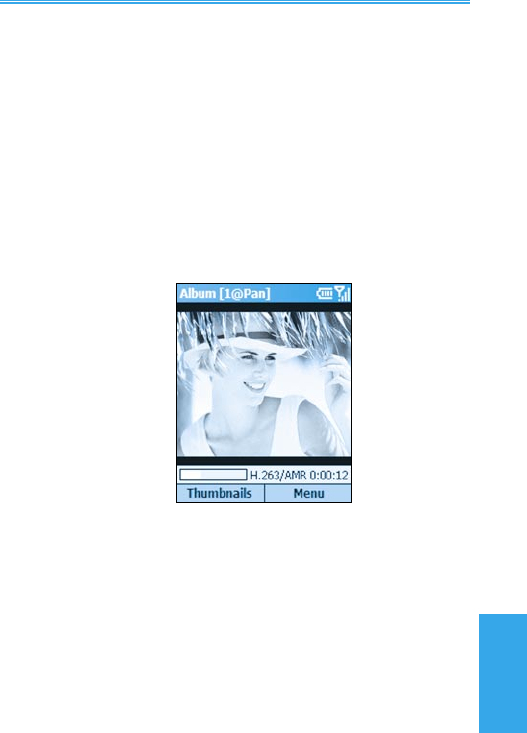
Smartphone User Manual
3.
Using your
camera
Smartphone User Manual
3.
Using your
camera
66
67
Detailed View mode
Detailed View mode utilizes more of the screen to display still
images or to play back video, animated GIF, or audio les.
Press the Left or Right navigational button to display the
previous or next le. Press the Up or Down button to Zoom
In or Out. If too large to t in the display area, press the
Action button to switch to Pan mode. You can then press
Up/Down/Left/Right to pan the desired portion into view.
The Title Bar displays the index number of the le, and indi-
cates whether Pan mode or Zoom mode is active.
A progress bar and time counter near the bottom of the
screen indicate the le format (and the amount of time that
has elapsed duiring the playback, if a video le).
If you wish to view les in Full Screen mode, select View >
Full Screen from the menu, or press the 6 button on your
keypad to toggle between Detailed View and Full Screen.
Press 7 to play/pause, or 8 to mute/unmute audio play.
Press * for Actual Size, or # for a Fit-in-window display.

Smartphone User Manual
3.
Using your
camera
Smartphone User Manual
3.
Using your
camera
68
69
Slide Show view mode
First, in Thumbnail View mode, select the thumbnail that you
want to appear initially in the slide show. Then select Slide
Show from the menu. The slide show will then begin with
the currently selected le.
Or, as a shortcut, you can press 0 when in either Thumbnail
View or Detailed View to start a slide show. Each image,
video, and audio le in the current folder will be played us-
ing the full screen, according to the settings that have been
specied in the Slide Show Options screen.
The Slide Show Options screen can be accessed by either
selecting Slide Show Options from the menu during Slide
Show view mode, or by selecting Options > Slide Show
from the menu when in Thumbnail View mode. The options
are summarized in the next section.
During a slide show, pressing 6 will also toggle the display
of the Title Bar and Softkey Labels on and off; or, select
Full Screen from the menu. Even if the Softkey labels are
not displayed, you can still press the Right Softkey to open
the menu, or the Left Softkey to end the slide show. You
can also end a slide show by selecting End Show from the
menu, or by pressing the * button or your Smartphone’s
Back button.
To pause a slide show, press the Action button. When
ready to continue playing the slide show, press the Action
button again.
During a slide show, you can press the Left and Right navi-
gational buttons to traverse to the previous or next slide.
To choose the type and speed of transition effects to be used
during a slide show, select Transition Effects from the menu
when in Slide Show view. Or, when in Thumbnail view, you
can select Options > Transition Effects from the menu.

Smartphone User Manual
3.
Using your
camera
Smartphone User Manual
3.
Using your
camera
68
69
Summary of Options screens
Select Options from the menu when in Thumbnail view to
access the following screens:
General
The options in this screen let you choose whether or not
to:
• Search subfolders of the current folder for les of the
supported types.
• Show the images in ROM in the Album screen.
• Force backlight and power to remain on during video and
audio playback.
• Mute audio while playing video les.
• Automatically replay video, audio, and animated GIF
les.
• Show or hide the Progress Bar during playback in Detailed
View.
• Automatically rotate left, right, or never.
Slide Show
In this screen you can specify:
• The amount of time each le will display during the slide
show.
• A rule for slide rotation during slide shows.
• The order of slide play (forward, backward, or random).
• Whether or not to force the backlight and system power
to stay on during a slide show.
• Whether or not you want each slide show to start in Full
Screen view (Title Bar and Softkey labels are hidden).

Smartphone User Manual
3.
Using your
camera
Smartphone User Manual
3.
Using your
camera
70
71
Transition Effects
Select from dozens of transition effects to be used between
slides during a slide show, and specify the speed. This
screen also lets you preview each choice before selecting
it.
Sort By
Lets you sort the sequence of the les in the current folder
according to Name, Date, Size, or Type. Then specify As-
cending or Descending order.
Thumbnail
Choose the size for the thumbnails displayed in Thumbnail
mode: Small, Normal, Large, Portrait, or List view. In addi-
tion, you can optionally show an index number in the upper
left corner of each thumbnail; and an “Info Bar” in which data
about the selected le is displayed.
Association
Choose the letypes you want to associate with Album.
Then, whenever you select a le of that type, it will auto-
matically be opened in Album (Bitmap, JPEG, GIF, AVI,
MPEG4, MIDI, and WAV).
Network
The values in the two UDP Port Range elds refer to the
range of protocol used to transfer data through the Internet.
These should already be assigned to the optimal values by
your operator, and normally will not need to be changed.
Specify the network to be used in the Connect Via eld.

Smartphone User Manual
3.
Using your
camera
Smartphone User Manual
3.
Using your
camera
70
71
Summary of Menu Functions
Some of the functions that the menus in Thumbnail View
and Detailed View allow you to perform:
• Send the selected le via MMS or E-mail.
• Delete, move, or copy the selected le.
• Save As a Caller ID Photo.
• Save As RingTone Line 1 or Line 2 (if a MIDI le is
selected).
• Rename the selected le.
• View Properties of the selected le (such as name, folder,
date, size, type, colors, frames, dimensions, resolution,
audio type, channel, etc.).
• View the current le in Full Screen (Title Bar and Softkey
labels are hidden).
• Rotate an image 90 degrees clockwise.
• Change to another folder and display les of the supported
letypes in that folder, including sub-options to switch to
\My Documents on your SD card, jump up one level, or
select recently visited folders.
• The New command in Thumbnail view includes a sub-
option to invoke the voice recorder function of your phone
and record a Voice Note.
• Switch to Camera mode.

Smartphone User Manual
3.
Using your
camera
72

Chapter 4
Personalizing your
Smartphone
4.1 Customizing Smartphone
settings

Smartphone User Manual
4.
Personalizing
Smartphone User Manual
4.
Personalizing
74
75
4.1 Customizing Smartphone
settings
You can easily view and change various settings in your
Smartphone. For example, you can use your own sounds
for ring tones, use your favorite photo for the Home screen
background, set up Call Forwarding to manage your calls
more efciently, and more.
In the Home screen, select Settings from the Start menu.
The items in the Settings screen are illustrated below.
Phone
When you select Phone in the Settings screen shown
above, the Phone screen appears and offers the following
options:
Call Barring
Enables you to block incoming and/or outgoing calls.
Call Forwarding
Enables you to forward calls to another number.

Smartphone User Manual
4.
Personalizing
Smartphone User Manual
4.
Personalizing
74
75
Call Options
Specify your Voice Mail number, SMS Service Center number,
Country code, and Area code. If you check the Any key an-
swer checkbox, you will be able to answer incoming calls by
pressing any key. If Show SIM Contacts is checked, entries
on the SIM card will be displayed in your Contacts list.
Call Waiting
Turn the Call Waiting function on or off.
Caller ID
Let your identication be known to all callers; to only the people
in your contacts; or to no callers.
Channels
Congure cell broadcast.
Fixed Dialing
Limit your calling area to one or more specic phone numbers
and/or area codes.
Networks
Identies your current network, and allows you to change your
network selection from Automatic to Manual. In addition, the
menu in the Networks screen lets you nd a new network,
select a network, and list preferred networks.

Smartphone User Manual
4.
Personalizing
Smartphone User Manual
4.
Personalizing
76
77
Sounds
Sounds settings are used to customize the sounds for ring
tones, notications, and reminders.
Select Settings from the Start menu, then select Sounds
in the Settings screen. The Sounds screen will open, in
which you can specify what sound le to use for the follow-
ing functions:
• Ring tone
• Reminders
• New E-mail arrival
• New text message arrival
• New voice message arrival
• New instant message arrival
• New channel message arrival
• Alarm clock
• SIM toolkit messages
• Exclamation
• Question
• Warnings
• Keypad control
After selecting one of the elds above, you can press the
Right or Left navigational buttons to select different sounds.
Or, press the Action button to open the Select an Item screen
to view the entire list of sounds available for that eld, and
select from that screen.
You can use the menu in the Sounds screen to Play or
Delete the selected item.
Press the Left Softkey ("Done") to save all changes.

Smartphone User Manual
4.
Personalizing
Smartphone User Manual
4.
Personalizing
76
77
To use your own sound:
1. Go to where your sound le is stored on your desktop
computer and copy the le.
2. In ActiveSync on your desktop computer, click Explore,
go to \Storage\Application Data\Sounds, then paste the
sound le into the Sounds folder.
3. In the Home screen of your Smartphone, select Settings
> Sounds from the Start menu.
4. Select the desired category (such as Ringtone, Reminders,
New E-mail, etc.), specify a sound, then press the Left
Softkey ("Done").
Proles
Prole settings are used to congure how your Smart-
phone noties you of events such as an incoming call, an
approaching appointment, or an arriving message. For ex-
ample, when you are attending a meeting, you can choose
the Meeting prole, which lowers the ring of your Smartphone
and noties you of incoming calls via vibration. Each prole
is pre-dened to use either an audible ring notication, or
a vibration notication, with different alarm types, volumes,
etc., as shown on the next page.
On the Start menu, select Settings > Proles. Select the
desired prole, then press the Left Softkey ("Done").
You can also select a different prole using the Quick List.
To display the Quick List screen, press the Power button on
your Smartphone and release quickly. Scroll to the desired
prole and then press the Action button to select it.

Smartphone User Manual
4.
Personalizing
Smartphone User Manual
4.
Personalizing
78
79
The following table lists the proles that come with your
Smartphone, and their default attibutes.
Prole
Name
Ring
Type
Ring
Volume
Alarm
Type
Alarm
Volume
Noti-
cation
Type
Noti-
cation
Volume
System
Sound
Volume
Normal Ring 3 Increasing 3 Play
sound
3 3
Silent Vibrate Off Vibrate Off Vibrate Off Off
Meet-
ing
Vibrate 1 Play
sound
1 Play
sound
1 Off
Out-
door
Ring Loud Increasing Loud Play
sound
Loud Loud
Auto-
matic
(Toggles between the Normal prole and the Meeting prole, based on your
Calendar)
Head-
set
Ring 3 Increasing 3 Play
sound
3 3
Car Ring 4 Increasing 4 Play
sound
4 4
Speak-
er
phone
Ring Loud Increasing Loud Play
sound
Loud Loud
To edit a prole's default attributes, select the desired prole
in the Proles screen, then select Edit from the menu. If you
later want to restore the settings back to the default attributes,
select Reset to default from the menu.

Smartphone User Manual
4.
Personalizing
Smartphone User Manual
4.
Personalizing
78
79
Home screen
Home screen settings are used to change the Home screen
layout, the color scheme, the background image, and the
time delay before the Home screen appears when your
Smartphone is idle.
To view or change these settings, open the Start menu, then
select Settings > Home Screen.
Note that the images available for selection in the Back-
ground Image eld are those currently in the \Storage\My
Documents folder of your Smartphone. (If the image le
you want to use is not there, copy the le to \Storage \My
Documents.)
About
Select Settings > About from the Start menu to open
the About screen, which displays information about your
Smartphone's operating system such as version numbers,
copyright information, total/available storage, and total/
available memory.
Accessibility
Select Settings > Accessibility to view or modify your set-
tings for System Font Size, Multipress Time-out, Conrma-
tion Time-out, and In-call Alert Volume.

Smartphone User Manual
4.
Personalizing
Smartphone User Manual
4.
Personalizing
80
81
Beam
If you want to receive infrared or Bluetooth beams from other
devices, you must turn on the option to receive incoming
beams.
To receive incoming beams:
1. Select Settings > Beam from the Start menu.
2. Select Receive incoming beams. Your Smartphone will
receive all incoming beams from other devices until you
clear this option.
Bluetooth
Please see the next chapter for usage of this setting.
Certicates
On your Smartphone, you can add and delete public key
certicates. These certicates help establish your identity
when you log on to a secure network, such as a corporate
network. Certicates also help establish the identity of other
computers, such as servers, with which you connect. This
helps prevent unauthorized users from accessing your de-
vice and its information.
You can store two types of certicates on your Smartphone:
personal certicates that establish your identity, and root
certicates that establish the identity of servers with which
you connect. Your Smartphone may include a set of pre-
installed certicates.

Smartphone User Manual
4.
Personalizing
Smartphone User Manual
4.
Personalizing
80
81
Certicates that establish your identity:
Select Settings > Certicates > Personal, then select
View from the menu to view the selected certicate, or
Delete to delete it.
Certicates that identify servers you've connected to:
Select Settings > Certicates > Root, then select View
from the menu to view the selected certicate, or Delete
to delete it.
Data Connections
Please see the next chapter for usage of this setting.
Date and Time
Select Settings > Date and Time to change your local time
zone, the current date and time, set the alarm time, and turn
the alarm feature on or off.
Owner Information
Select Settings > Owner Information from the Start menu
to enter your personal information such as name, phone
number, and E-mail address. This is helpful, for example,
in the event that you lose your Smartphone, so that you can
be contacted if it is found. In the Owner Information screen,
there is also a Notes eld in which you can enter any other
miscellaneous information if desired.

Smartphone User Manual
4.
Personalizing
82
Power Management
Select Settings > Power Management from the Start menu
if you want to check the current battery level. Also in the
Power Management screen, you can adjust various power-
saving settings. Backlight time-out, Display time-out, and
Light Sensor enabled or disabled.
The light sensor is located at the bottom of your Smart-
phone, under the 0 button on your keypad. Selecting On in
the Light Sensor Enable eld will cause a blue “backlight”
behind the keypad to activate in dark conditions, making
it easier to see the buttons. Selecting Off in this eld will
conserve battery power, but there will be no keypad light in
a dark environment.
NOTE: You can also view the Battery Level in the form of
a percentage, using the File Manager application described
in Chapter 8. (Select System Info from the menu in File
Manager.)
Regional Settings
In the Regional Settings screen, (Settings > Regional Set-
tings), you can change the language used by your phone.
After changing the language and some of the other settings,
you must power the phone off and back on in order to make
the changes take effect. The following items can be adjusted:
Language, Locale, Short Date style, Long Date style; and the
format of Time, Positive numbers, Negative numbers, Posi-
tive currency amounts, and Negative currency amounts.

Chapter 5
Getting Connected
5.1 Connecting to the Internet
5.2 Pocket Internet Explorer
5.3 Bluetooth
5.4 Modem Link

Smartphone User Manual
5.
Getting
Connected
Smartphone User Manual
5.
Getting
Connected
84
85
5.1 Connecting to the Internet
When in the Home screen, select Settings > Data Connec-
tions to access the Data Connections screen. The settings
in this screen enable you to set up Dial-up, Virtual Private
Network (VPN), Proxy, and General Packet Radio Service
(GPRS) connections so you can connect to the Internet or
your corporate network.
With a data connection, you can browse the Web, download
E-mail, chat using MSN Messenger, or synchronize wire-
lessly with the server. Check with your service provider to
see if a data connection has already been set up for you,
and if over-the-air conguration is supported.
Dial-up Connections
You need to set up a dial-up connection to connect directly
to the Internet or to your corporate network.
To create a dial-up connection to the Internet:
1. When in the Home screen, select Settings > Data
Connections.
2. Press the Right Softkey to open the menu in the Data
Connections screen and select Edit Connections.
3. Select Dial-up Connections in the Connections
screen.
4. In the Dial-up Connections screen, select Add from the
menu.
5. In the Add Dialup screen, enter a name for the connection
in the Description eld.
6. In the Connects to eld, select The Internet.
7. Enter the appropriate information for the remaining elds,
and press the Done softkey.

Smartphone User Manual
5.
Getting
Connected
Smartphone User Manual
5.
Getting
Connected
84
85
To create a dial-up connection to your corporate net-
work:
1. When in the Home screen, select Settings > Data
Connections.
2. Press the Right Softkey to open the menu in the Data
Connections screen and select Edit Connections.
3. Select Dial-up Connections in the Connections screen.
4. In the Dial-up Connections screen, select Add from the
menu.
5. In the Add Dialup screen, enter a name for the connection
in the Description eld.
6. In the Connects to eld, select Work.
7. Enter the appropriate information for the remaining elds,
and press the Done softkey.
In the same way as above, you can choose the following in
the Connections screen, then select Add from the menu to
add new connections:
VPN Connections
A VPN connection is used to access your corporate network
using an existing Internet connection.
Proxy Connections
A Proxy connection is used to access the Internet using an
existing connection to your corporate or a WAP network.
GPRS Connections
If there is GPRS coverage in your area, you can set up a
GPRS connection to access your corporate network or the
Internet, which is faster than a Dial-up connection.

Smartphone User Manual
5.
Getting
Connected
Smartphone User Manual
5.
Getting
Connected
86
87
Options
After selecting Settings > Data Connections, you can
select Options from the menu in the Data Connections
screen to specify number of redial attempts, amount of idle
time to wait before disconnecting, and type of connection
your desktop has.
Adding a URL Exception
Some URLs for Web pages on your company Intranet may
use periods, for example: intranet.companyname.com. To
view these pages in Pocket Internet Explorer, you must
create a URL exception. Otherwise, the pages will not
display.
NOTE: You do not need to create URL exceptions for
Internet URLs.
1. Select Settings > Data Connections from the Start
menu.
2. Select Work URL Exceptions from the menu.
3. Select Add from the menu.
4. In the URL Pattern eld, enter the URL. Separate multiple
URLs with a semicolon (;). Then select Done.

Smartphone User Manual
5.
Getting
Connected
Smartphone User Manual
5.
Getting
Connected
86
87
5.2 Pocket Internet Explorer
Using Pocket Internet Explorer (IE), you can browse the World
Wide Web on your Smartphone. Pocket IE supports HTML
(Hypertext Markup Language), cHTML (compact Hypertext
Markup Language), xHTML, WML 2.0, and WAP (Wireless
Application Protocol). It also supports JScript, ActiveX
controls, and CSS (cascading style sheets). The browser
supports images and sounds, but it does not support frames
on a Web page.
Starting Internet Explorer
When in the Home screen, select Internet Explorer from
the Start menu.
The rst time you do this, a default list of Favorites should
appear. If you select one and then press the Action button
or the Left Softkey (“Go”), IE will open that web page.
Entering a URL
To go to a WWW site not listed in your Favorites, open the
menu and select Address Bar. In the Address Bar screen,
enter the desired URL, then press the Go softkey.
Viewing a list of recently-visited web pages
In the Address Bar screen, select View History and then
press the Action button or the Go softkey to view a list of
recently-visited Web pages. To go to a Web page listed in
the History screen, select it and then press the Action button
or the Go softkey.
Press the Back button on your Smartphone to return to a
Web page you visited in the same session.
The Smartphone caches the Web pages that you view and
stores them until the cache is full. It then replaces the oldest
pages with the new pages. If you go back to a page that is
cached on your phone, you see the stored version unless
you refresh the page to see the latest version.

Smartphone User Manual
5.
Getting
Connected
Smartphone User Manual
5.
Getting
Connected
88
89
NOTE: While you are connected to the Internet, you can
change between Pocket Internet Explorer and other pro-
grams on your Smartphone by pressing the Home key and
invoking the program you want. This does not close your
Internet connection. Subsequently returning to Internet
Explorer in the same phone session would re-display the
most recently opened Web page. (To terminate the Inter-
net Explorer program, you can use the Task Manager utility
explained in Chapter 9.)
Using the Favorites list
If you see a Web page you want to visit another time, mark
it as a favorite. The next time you want to visit that Web
page, you can select it from your Favorites list.
If you select Add Favorite from the menu when the desired
Web page is open, the name and URL of the current page is
already lled in. You can edit the Name eld and/or Address
(URL) eld if necessary. If you previously created additional
folders, select a folder in the Folder eld. Then select Add
to add it to your Favorites.
By default, only the Favorites folder exists. To create a new
folder in which to place URLs, select Add Folder from the
menu in the Favorites screen.
To edit the Name, Address (URL), or Folder elds of an
existing entry in your favorites, select the desired Favorite in
the list, then select Edit from the menu. To delete a favorite,
select Delete.
Customizing Pocket Internet Explorer
You can customize Web browsing options, change the net-
work to connect to, and make more memory available on your
phone by clearing stored cookies and Web pages.
Select Options from the menu, then select either General,
Connections, Memory, Layout, or Properties.

Smartphone User Manual
5.
Getting
Connected
Smartphone User Manual
5.
Getting
Connected
88
89
5.3 Bluetooth
Bluetooth is a short-range wireless communications tech-
nology. Devices with Bluetooth capabilities can exchange
information over a distance of about 10 meters (30 feet)
without requiring a physical connection.
Unlike infrared beaming, you don't need to line up the de-
vices to beam information with Bluetooth. The devices only
need to be within a range of about 10 meters. You can even
beam information to a device in a different room, as long as
it's within range.
The software included with your Smartphone allows you to
use Bluetooth to beam information such as les, contact
cards, appointments, and tasks to other Bluetooth-enabled
devices.
Bluetooth modes
Select Settings > Bluetooth > Bluetooth. Then select On,
Off, or Discoverable. The behavior of each of these modes
is summarized below.
On — The Bluetooth radio is turned on and you can use
Bluetooth features.
Off — The Bluetooth radio is turned off. You might want to
turn the radio off at times to conserve battery power, or in
situations where radio use is prohibited, like on airplanes
and in hospitals. Bluetooth is also turned off when you turn
Flight Mode on.
By default the Bluetooth radio is turned off. If you turn it on,
and then turn off your Smartphone, the Bluetooth radio also
turns off. When you turn on your phone again, the Bluetooth
radio turns on automatically.

Smartphone User Manual
5.
Getting
Connected
Smartphone User Manual
5.
Getting
Connected
90
91
Discoverable — The Bluetooth radio is turned on, and any
other Bluetooth devices within range (about 10 meters) can
detect your device and attempt to beam information to it,
establish a bond, or use a Bluetooth service. In this mode,
other devices can detect your device, whether or not a bond
has been created. However, in order to receive a beam from
another device, you must accept it on your device.
If you no longer want your device to be discoverable, select
Off to turn off the radio; or On to leave the radio on but not
allow detection by other devices.
NOTE: Bluetooth must be set to Discoverable mode if you
want to use it in conjunction with Modem Link. See the next
section, 5.4 Modem Link.
Bonds
A bond is a relationship that you create between your
Smartphone and another Bluetooth device in order to ex-
change information more securely. Creating a bond involves
entering the same personal identication number (PIN) on
the two devices you want to bond. Once a bond is created,
the devices recognize the bond and are able to exchange
information without your entering a PIN again.
To create a bond:
1. Make sure that the two devices are within 10 meters of
each other and that Bluetooth is in discoverable mode on
both devices.
2. When in the Home screen, select Settings > Bluetooth
> Bluetooth from the Start menu.
3. Select Bonded Devices from the menu, and then New.
Your device searches for other Bluetooth devices and
displays them in the list.
4. Select the device you want, then select Add.

Smartphone User Manual
5.
Getting
Connected
Smartphone User Manual
5.
Getting
Connected
90
91
5. In PIN, enter a PIN of between 1 and 16 characters, and
select Done.
6. Enter the same PIN on the other device.
7. If desired, enter the name of the other device in Name,
and select Done.
To accept a bond:
1. Make sure that Bluetooth is turned on and in Discoverable
mode.
2. When prompted to bond with the other device, select
Yes.
3. In PIN, enter a PIN of between 1 and 16 characters, and
select Done. You must enter the same PIN that was
entered on the device requesting the bond.
4. Optionally, you can enter the name of the device requesting
the bond in the Name eld.
5. Select Done. The bond is now created. You can now
exchange information with the other device.
To delete a bond:
1. Select Settings > Bluetooth > Bluetooth from the Start
menu.
2. Select Bonded Devices from the menu.
3. Select the bond you want to delete, then select Delete
from the menu.
NOTE: Select Settings > Bluetooth > BT Setting to enter a
name for your device; to enable/disable Beam Authentication
requirements; or perform ActiveSync setup (bond with other
Bluetooth device which supports serial port or ActiveSync
prole as your ActiveSync partner).

Smartphone User Manual
5.
Getting
Connected
92
5.4 Modem Link
Using Modem Link, you can use your Smartphone as an
external modem for another device or computer by using an
infrared, bluetooth, or USB connection.
To set up an infrared, USB, or Bluetooth connection:
1. Ensure that your Smartphone is not connected to another
device.
2. Select Accessories > Modem Link from the Start
menu.
3. In the Connection field, select USB, IrCOMM, or
Bluetooth. The default Baud Rate is set at 115,200.
4. Press the Right Softkey to open the menu in the Modem
Link screen, then select Activate from the menu.
5. Press the Left Softkey (“Done”).
NOTE: In order for the Bluetooth option to be available in
the Connection eld in Step 3 above, you need to set Blue-
tooth to Discoverable mode as described earlier in Section
5.3. You also need to enable Bluetooth Modem capability
on your desktop/laptop PC (Start menu > Settings > Net-
work and Dial-up Connections). In addition, when creating
a new modem on your desktop/laptop PC, you must enter this
Extra Initialization command in the Properties > Advanced
tab: AT+CGDCONT=1,”IP”,”APN eld”,””,0,0. (In this
command, the value you insert in the APN eld position
depends on your operator.)
For details about setting up Modem Link with a desktop PC
or laptop PC, please refer to the separate User’s Manual
for Modem Link.
Deactivating:
To deactivate the Modem Link at any time, select Deactivate
from the menu in Step 4 above. (Failing to deactivate the
modem link when you are nished using it might result in
problems with using ActiveSync in the same session.)

Chapter 6
Messaging Features
6.1 Setting up accounts
6.2 Managing accounts
6.3 Creating messages
6.4 Receiving E-mail and SMS
messages
6.5 Viewing message folders
6.6 Managing Messaging
6.7 Instant messaging
6.8 MMS messaging
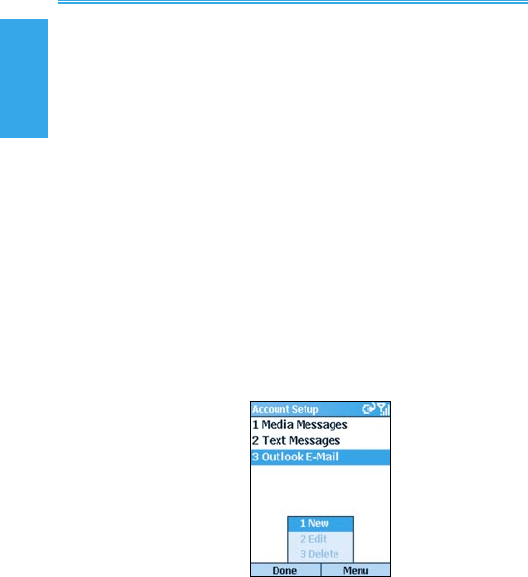
6. Messaging
features
Smartphone User Manual
94
6. Messaging
features
Smartphone User Manual 95
6.1 Setting up accounts
Your Smartphone is equipped with powerful messaging
features such as the ability to send and receive E-mail,
Short Message Service (SMS), and Multimedia Messaging
(MMS). It also allows you to view and manage your mes-
sage folders, customize message notications and use MSN
Messenger to communicate with others. Please note that
not all E-mail services allow users to set up POP3 on mo-
bile devices. Consult your network administrator or service
provider for more information on toll and service charges or
other related information. This section describes the steps
required for setting up your Smartphone to send and receive
E-mail messages.
Conguring E-mail accounts
You can send E-mail messages by synchronizing or by con-
necting directly to an E-mail server through your Internet
service provider or a corporate network.
To set up an E-mail account:
1. When in the Home screen, select Start > Messaging.
2. Select Outlook E-mail > Menu > Options.
3. Select Account Setup > Menu > New.
4. Enter your display name for this E-mail account, and your
E-mail address, and select Next.

6. Messaging
features
Smartphone User Manual
94
6. Messaging
features
Smartphone User Manual 95
NOTE: Before conguring E-mail on your Smartphone, you
must have an Internet and E-mail account. You will also
need to congure your Smartphone's data connection, as
described in Chapter 5.
5. In E-mail address, enter the address for this account.
Leave the Automatic setup box checked to obtain E-mail
setting from the Internet. Your Smartphone will make an
Internet connection and attempt to determine the server
settings for E-mail.
6. In User name, enter your user name. This is usually the
rst part of your E-mail address, which appears before the
"at" sign (@).
7. In Password, enter your password.
8. In Domain, enter the domain name, if required.
9. To save your password, so that you do not need to enter it
each time you connect to your E-mail server, select Save
password > Next.
NOTE: If you save your password and then lose your phone,
your E-mail could be accessed by someone else.
10.In Server type, scroll to select the type of E-mail server
that hosts your mailbox (IMAP4 or POP3) and select Next.
In Account name, enter a name for this account. You
must use a different name for each account that you set
up.
11.In Network, scroll to the type of network that your E-mail
server runs on and select Next.
12.Enter information about your E-mail servers and select
Next. If you are not sure what to enter, ask your network
administrator.
13.Select message download options and select Next.
14.Select a connection option, then select Next > Finish.

6. Messaging
features
Smartphone User Manual
96
6. Messaging
features
Smartphone User Manual 97
6.2 Managing accounts
Use and manage up to eight messaging accounts with your
Smartphone.
Viewing the list of accounts
In the Home screen select Start > Messaging. The list of
accounts that display the number of unread messages in the
Inbox of each account is shown in parentheses.
Moving between accounts
If you have an account open, you can quickly switch to
another account by scrolling right or left, or selecting Menu
> Switch Accounts.
Changing E-mail account options
In the Home screen, select Start > Messaging and then
select an account. Select Menu > Options and then select
the type of option to change. Select Done to conrm.
Deleting an account
In the Home screen, select Start > Messaging, and then se-
lect an account. Select Menu >Options > Account Setup.
Scroll to an account and then select Menu > Delete.

6. Messaging
features
Smartphone User Manual
96
6. Messaging
features
Smartphone User Manual 97
6.3 Creating messages
You can start creating a new E-mail, text message (SMS),
or media message (MMS) from Messaging. You can also
create a new E-mail or text message from Contacts. Only
numbers input are allowed for SMS and MMS messages,
and E-mail addresses for E-mail messages.
To create a message in messaging:
1. In the Home screen, select Start > Messaging.
2. Highlight and select an account, and select New.
3. In To, enter recipient E-mail address, SMS number. Insert
a semicolon (;) between multiple addresses or numbers.
4. In Cc, enter the E-mail addresses of persons to receive a
copy. This eld does not appear for SMS messages.
5. In Subj, enter a subject. This eld does not appear for
SMS messages.
• To save time you can insert predefined text into
messages. In Subj, select Menu > Insert Text for
E-mail and text messages; scroll to the text and select
Insert.
• You can also insert a voice recording into a message.
Select Menu > Insert Recording, and you will be
prompted to start recording.
• At anytime, you can request a delivery receipt by
selecting Menu > Message Options, and then check
on the "Request message delivery notication" box.

6. Messaging
features
Smartphone User Manual
98
6. Messaging
features
Smartphone User Manual 99
To create a message from a contact card:
1. In the Home screen, select Start > Contacts.
2. Select the contact, select the E-mail address or text
message number to use.
3. Select the account to use; in Subj, enter a subject. This
eld does not appear for text messages.
4. Enter a message. Select Send. E-mail messages are
stored in Outbox and sent to recipients the next time you
synchronize or connect your E-mail server and receive
mail. Text messages are sent immediately.
You can send and receive SMS messages up to 160 char-
acters in size. If a SMS message is longer, it is automati-
cally sent in chunks as several small SMS messages, and
is then unied as one SMS message after all of the small
SMS messages have been received.
To cancel a message, select Menu > Cancel Compose.
Saving a draft of a message
You can save a draft of a message that you are composing
to nish and send later. On the Home screen, select Start
> Messaging. Choose an account and select New. Enter
information in the message. Select Menu > Postpone Mes-
sage. A draft of the message is stored in the Drafts folder
of the account.
Reopening and sending a message draft
In the Home screen, select Start > Messaging. Select an
account and select Menu > Folders. Select Drafts and then
scroll to the draft message to open.
Edit the message and select Send. E-mail messages are
stored in Outbox and sent to recipients the next time you
synchronize or connect to your E-mail server and send and
receive mail. Text messages are sent immediately. For
information about how to send media messages, go to sec-
tion 6.8 of this chapter.

6. Messaging
features
Smartphone User Manual
98
6. Messaging
features
Smartphone User Manual 99
Inserting signatures into messages
For each messaging account, you can specify a signature to
be automatically inserted into messages that you send.
To specify a signature to insert:
1. In the Home screen, select Start > Messaging.
2. Choose the account, select Menu > Option >
Signatures.
3. Scroll right to switch to the account for which to specify a
signature.
4. Select Use signature with this account.
5. To insert a signature in every message you send, select
Include when replying and forwarding. Otherwise, a
signature is inserted only in new messages.
6. Replace the text within the Signature box with a signature
to insert, and select Done. The signature is inserted into
messages that you send from this account.
To stop inserting a signature:
1. In the Home screen, select Start > Messaging.
2. Select the appropriate item (Media Messages, Outlook
E-Mail, etc.).
3. Select Options from the menu, then select Signatures
from the list.
4. In the Signatures screen, select the account for which you
want to stop inserting a signature into messages.
5. Clear the Use signature with this account checkbox,
then select Done. A signature will no longer be inserted
into messages that you send from this account.

6. Messaging
features
Smartphone User Manual
100
6. Messaging
features
Smartphone User Manual 101
6.4 Receiving E-mail, and SMS
messages
You can receive E-mail and SMS messages through Inbox
synchronization or by connecting to your E-mail server. You
can then view all of the messages in your Inbox.
When you connect to the E-mail server or synchronize your
Inbox with your PC, only the rst 0.5 KB of each new mes-
sage are downloaded to Inbox on your phone by default.
Only small attachments are downloaded and the original
messages remain on the E-mail server or your computer.
When you receive an E-mail message, your Smartphone
plays a sound and displays an envelope icon at the top of
the screen. By default, the Home screen also displays the
number of unopened E-mail and SMS messages. To quickly
view new messages, scroll down and select the message
notication area on the Home screen, or select the Mes-
sage soft key.
Working with the message list
Received messages are displayed and stored in the Inbox
folder of the appropriate account. By default, messages are
displayed in the order received, allowing you to change the
display order and date of sent messages.
Icon indicates new
message
Select to go to
Messaging

6. Messaging
features
Smartphone User Manual
100
6. Messaging
features
Smartphone User Manual 101
Viewing the Inbox message list
In the Home screen, select Start > Messaging. Scroll right
or left, or press Menu then select the appropriate account.
The Inbox message list displays your received messages.
Changing message list display options
In the Home screen, select Start > Messaging. Highlight the
account, then select Menu > Options > Display. Change
the display options and select Done.
Marking a message as Read or Unread
In the Home screen, select Start > Messaging. Highlight
the account and scroll to the message to mark, then select
Menu > Mark as Read/Unread > Send.
The message is stored in Outbox and sent to recipients the
next time you synchronize or connect to your E-mail server.
SMS messages are sent immediately.
To forward a message:
1. From an open message, select Menu > Forward.
2. In To, enter recipient E-mail addresses or SMS numbers.
Insert a semicolon (;) between multiple addresses or SMS
numbers.
3. Optionally, you can enter an introductory message by
scrolling to the message area, pressing the Action key
to insert a blank line, and entering your text.
4. Select Send. SMS messages are sent immediately. E-
mail messages are stored in Outbox and sent to recipients
the next time you synchronize or connect to your E-mail
server.
Deleting a message:
In the Home screen, select Start > Messaging. Go to the account
in which to delete a message. Scroll to the message to delete.
Select Menu > Delete.

6. Messaging
features
Smartphone User Manual
102
6. Messaging
features
Smartphone User Manual 103
Working with large messages and
attachments
When you receive large E-mail messages and attachments,
your Smartphone downloads only a portion of them. You
can view the partial message or attachment and decide if
you want to download the rest of it.
When you synchronize, your Smartphone downloads the
rst 0.5 KB of each new E-mail message by default. When
you connect to an Internet E-mail server, it downloads the
amount (in KB) of each new message that you specied
when you set up the account. The message size includes
its attachments. The original messages and attachments
remain on the server or your PC.
The attachment size is omitted from messages received
from a POP3 E-mail server.
In the message list, messages with an attachment display
an envelope icon with a paper clip. Within a message, at-
tachments are displayed as a list of hyperlinks at the bot-
tom of the message, and are preceded by an attachment
icon. The hyperlink includes the le name and size of the
attachment.
The following icons indicate the state of each attachment
status:
Not downloaded.
Marked for download.
Downloaded.

6. Messaging
features
Smartphone User Manual
102
6. Messaging
features
Smartphone User Manual 103
Downloading a complete E-mail message
In the Home screen, select Start > Messaging. Select the
account and scroll to the message to download. Select
Menu > Mark for Download. The complete message is
retrieved the next time you synchronize or connect to your
E-mail server and send and receive E-mail.
Downloading an attachment
In an open message with an attachment to download, select
the attachment. The attachment is downloaded the next time
you synchronize or connect to your E-mail server and send
and receive E-mail. If there are multiple attachments in the
message, all attachments are downloaded.
View an attachment
In an open message containing a downloaded attachment,
select the attachment. Note that you can open attachments
only for les that are supported by the phone’s installed
applications.

6. Messaging
features
Smartphone User Manual
104
6. Messaging
features
Smartphone User Manual 105
6.5 Viewing message folders
Each messaging account has a set of folders in which your
Smartphone stores messages for that account.
• Deleted Items: contains messages that you delete until
you empty this folder.
• Drafts: contains messages that you save before send-
ing.
• Inbox: contains received messages.
• Outbox: contains sent E-mail messages awaiting syn-
chronization, or messages that will be sent upon the next
E-mail server connection. SMS messages are sent imme-
diately over the network and appear in your SMS Outbox
folder only for a few seconds.
• Sent Items: contains copies of sent messages.
You can move a message to a different folder within the
same account.
When you synchronize or send and receive E-mail, your
Smartphone synchronizes any additional E-mail folders that
you have created in Outlook on your desktop computer or
on your E-mail server. It also synchronizes the messages
contained in those folders, if the folders are marked for
synchronization.
To view message folder contents:
1. In the Home screen, select Start > Messaging.
2. Choose the account, select Menu > Folders.
3. Scroll to the account for which to view the contents of a
message folder.
4. Select Folders and then the folder to view.

6. Messaging
features
Smartphone User Manual
104
6. Messaging
features
Smartphone User Manual 105
Moving a message to a different folder:
In the Home screen, select Start > Messaging. Choose the
account and scroll to the message to move. Select Menu >
Move. Select the folder into which to move the message.
To empty the deleted items folder:
1. In the Home screen, select Start > Messaging.
2. Select Menu > Folders.
3. If necessary, scroll right or left to switch to the account for
which to empty the Deleted Items folder.
4. Select Folders > Deleted Items.
5. Select Menu > Empty Folder.

6. Messaging
features
Smartphone User Manual
106
6. Messaging
features
Smartphone User Manual 107
6.6 Managing messaging
All E-mail and SMS messages are stored in the respective
Inbox of each account in Messaging. By default, the most
recently received messages are displayed at the top of the
Inbox list. Using the menu options, you can customize your
Inbox settings to control the way you send, receive, and
view messages.
Using Messaging menu options
It is easy to accomplish common messaging tasks from your
Inbox. Press the New softkey to compose a new message,
or press the Menu softkey to forward, delete, and reply to
messages. Access Inbox options allow you to customize
and manage your messages.
To view messaging menu options:
In the Home screen, select Start > Messaging. Choose the
account and then press the Menu softkey.

6. Messaging
features
Smartphone User Manual
106
6. Messaging
features
Smartphone User Manual 107
The following table lists the Messaging functions found under
Menu:
Messaging Option Function
Delete Delete the selected message.
Reply Reply to an open or selected mes-
sage.
Reply All Reply to the sender and those who
received a copy of the open or se-
lected message.
Forward Forward the selected message.
Folders View the folders in this account.
Switch
Accounts
Switch between this account and
another.
Move Move the open or selected message
to another folder.
Mark as Read Display the header text of a message
in your Inbox in lightface, indicating
that the message has been read.
Mark for Download Retrieve the entire E-mail message from
the E-mail server the next time you con-
nect.
Options Display a list of Inbox options that you
can customize.
Send/Receive Connect to your E-mail server to send
and receive messages.

6. Messaging
features
Smartphone User Manual
108
6. Messaging
features
Smartphone User Manual 109
Customizing messaging options
You can optimize Messaging according to your work environ-
ment. For example, you can change the way your messages
are displayed, specify how you want your messages to be
sorted, specify the volume and limit the size of messages
you want to automatically download, and change your syn-
chronization schedule.
Accessing Options menu
In the Home screen, select Start > Messaging. Choose
the account, press the Menu > Options. Select the option
to customize. Modify the settings to change, and press
Done.
The following table lists the Options found under Menu Mes-
saging functions:
Options Menu Function
Display Change the message information
displayed in your inbox.
Sending Specify whether you want to include
an original copy of the message in
your reply, save a copy of your sent
message, or use Unicode for SMS
messages.
Edit My Text Edit the predened text so that you
can insert in messages.
Signatures Add a signature in messages.
Account Setup Set up your accounts.
Import SIM
Messages
Import SMS messages from a SIM
card to your inbox. The messages
are not removed from the SIM card
after they are imported.

6. Messaging
features
Smartphone User Manual
108
6. Messaging
features
Smartphone User Manual 109
6.7 Instant messaging
You can use MSN Messenger on your Smartphone to
send and receive instant messages. MSN Messenger on
your phone provides the same chat environment as MSN
Messenger on your desktop computer. Features of this
environment include:
• Sending and receiving instant messages.
• Seeing the status of others in your Messenger contacts
list, or changing your own status (e.g., available, busy, out
to lunch).
• Inviting other people to a chat.
• Blocking contacts from seeing your status or sending you
messages.
Setting up MSN Messenger
You need either a Microsoft .NET Passport account
or a Hotmail account to set up MSN Messenger. To
set up a Microsoft .NET Passport account, go to: http://
www.passport.com. Once you have an account, you need
to create a connection on your phone that allows you to
connect to the Internet. For more information about creating
connections, see Chapter 5.
Using MSN Messenger
You can sign in to MSN Messenger using your Hotmail
credentials or your .NET Passport.
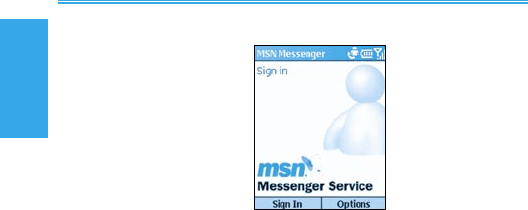
6. Messaging
features
Smartphone User Manual
110
6. Messaging
features
Smartphone User Manual 111
To sign in to and sign out of MSN Messenger:
1. In the Home screen, select Start > Messaging > MSN
Messenger > Sign In.
2. In Sign-in Name, enter the sign-in name that you use
for Hotmail or your .NET Passport (Example: name_
123@hotmail.com).
3. In Password, enter your Hotmail or .NET Passport
password.
4. Select Remember my password if you don't want to enter
your password again in the future.
5. Select Sign In.
6. To sign out, select Menu > Sign out.
NOTE: If you do not sign out of MSN Messenger, you will
remain on a data connection. This may result in additional
charges from your service provider.
Adding an MSN Messenger contact:
In the MSN Messenger contacts list, select Menu > Add
Contact. Add the Hotmail or .NET Passport sign-in name
of a person with whom you want to chat. Their sign-in name
is added to the contacts list.

6. Messaging
features
Smartphone User Manual
110
6. Messaging
features
Smartphone User Manual 111
Deleting an MSN Messenger contact:
In the MSN Messenger contacts list, select the contact.
Select Menu > Delete Contact.
Sending an instant message:
Sign in to MSN Messenger. Scroll to the contact with whom
you want to chat. Select Menu > Send Message. Enter
your message and select Send. This starts a chat with the
contact.
To reply to an instant message:
1. Select Menu > Chats.
2. Select the name of the person sending the instant
message. The message displays, along with a box for
your reply.
3. Enter your reply and select Send. If you want to be able
to receive instant messages at any time your phone
is connected to a network, select Menu > Options >
Passport Account > Run this program when connection
is available > Done.
Inviting a contact to an ongoing chat:
From a chat, select Menu > Invite and then choose a
contact. The contact receives an instant message and can
join the chat.

6. Messaging
features
Smartphone User Manual
112
6. Messaging
features
Smartphone User Manual 113
Changing between chats:
Select Menu > Chats. In the list of ongoing chats, select
the name of a contact with whom to chat.
Return to the contacts list:
From a chat, select Menu > My Contacts.
Ending a chat:
Select Menu > End Chat.
Seeing who is already chatting:
Select Menu > Chats.
Blocking or unblocking an MSN Messenger contact:
In the MSN Messenger contacts list, select the contact's
name. Select Menu > Block. The contact will no longer be
able to see your status or send you messages. To unblock
the contact, select Menu > Unblock.
Changing your status:
In the MSN Messenger contacts list, select your name.
Select a status description, such as Away. This status
is displayed next to your name in the contact lists of your
contacts.
Change your display name:
In the MSN Messenger contacts list, select Menu. Select
Options > Passport Account. In My display name, enter
your name as you want it to display in the contacts lists of
your contacts.

6. Messaging
features
Smartphone User Manual
112
6. Messaging
features
Smartphone User Manual 113
6.8 MMS messaging
You can use MMS to create, view, store, send, or receive
multimedia messages that include text, photos, videos, or
audio les.
Editing MMS Settings
1. Select Congurations from the Start menu.
2. Select MMS Settings. The Preferences screen will open.
The elds in this screen are explained below.
Retrieve Immediately — Choose whether or not to download
messages as soon as they are available on the server.
No. of Attempts — Specify the number of times your mes-
sages will attempt to be sent before stopping.
Connect Via — Select your type of Internet/Network con-
nection (Work, WAP Network, etc.).

6. Messaging
features
Smartphone User Manual
114
6. Messaging
features
Smartphone User Manual 115
Photo Resolution — Choose from a variety of resolutions
(160 x 120, 320 x 240, 640 x 480, etc.). Note that lower
resolutions will normally lessen the time needed to send/
receive a message.
MMSC Settings
The MMSC (“Multimedia Messaging Service Center”) set-
tings are normally pre-set to the appropriate values, and in
most cases you will not need to change them.
However, if you want to view or edit them, select MMSC Set-
tings from the menu in the Preferences screen. The MMSC
Settings screen will open. It contains the Name, MMSC URL,
WAP Gateway, and Max. Sending Size elds.
To view or edit the settings for an existing item, select the de-
sired item listed in the MMSC Settings screen and then press
the Left Softkey (“Edit”), or select Edit from the menu.
To create a new item, press the Right Softkey to open the
menu in the MMSC Settings screen, then select New from
the menu and ll in the Name, MMSC URL, WAP Gateway,
and Max. Sending Size elds.
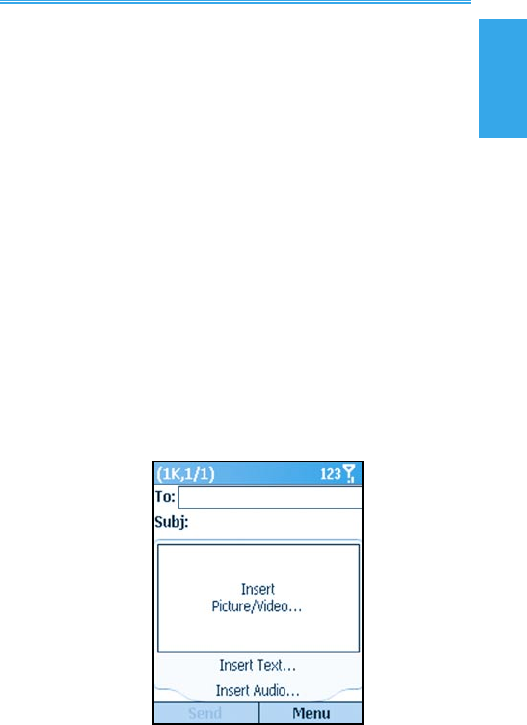
6. Messaging
features
Smartphone User Manual
114
6. Messaging
features
Smartphone User Manual 115
Creating and sending an MMS message
MMS Composer lets you create messages consisting of
multiple slides. Each slide can contain a photo or video,
audio (with photos only), and text. Messages will display
similar to a slide show. You can then send your messages
to other mobile devices or e-mail accounts.
MMS Composer is structured like most typical mail pro-
grams. It consists of the Inbox, Outbox, Sent Items, Drafts,
and Deleted Items folders. To change folders, ensure that
you are in the proper MMS account, then select Folders
from the menu. The steps below assume you are in the
Inbox, Outbox, or Sent Items folder.
1. Select Messaging from the Start menu. In the
Messaging screen, select Media Messages.
2. Press the Left Softkey (“New”).
3. An empty message screen will appear. In the To eld,
enter the recipient’s phone number or e-mail address.
You can enter it manually, or press the Action button or
select Insert Contact from the menu, to choose a person
from your Contacts. In the Subj eld, enter a subject.
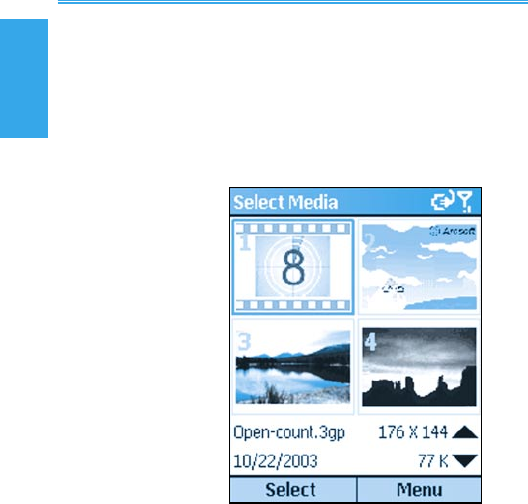
6. Messaging
features
Smartphone User Manual
116
6. Messaging
features
Smartphone User Manual 117
• To insert a Photo or Video le:
a. In the screen shown on the previous page, select the
Insert Picture/Video... box. (If necessary, press the
Up or Down button on the navigation pad to select.)
b. Press the Action button. All of your available photo and
video les will be displayed in a Thumbnail view.
c. Highlight the photo or video you want to attach, and
press Select.
In addition, the menu (Right Softkey) accessed
from the Select Media screen contains the following
commands:
Select — Inserts the currently highlighted photo/video
into your message.
Play/Open — Plays the highlighted video or opens
the highlighted photo.
Information — Displays various data about the
selected le.
Delete — Removes the selected le.
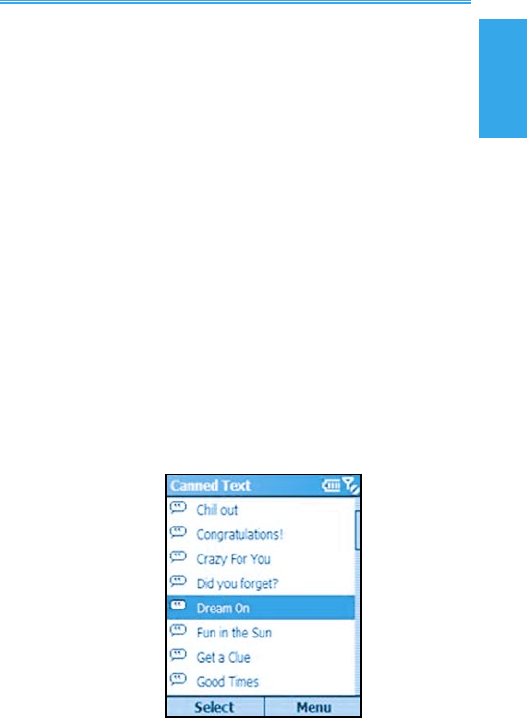
6. Messaging
features
Smartphone User Manual
116
6. Messaging
features
Smartphone User Manual 117
Capture Picture — Lets you take a new picture using
your Smartphone’s built-in camera, and attach it to the
MMS slide.
Capture Video — Lets you capture a new video clip
using your Smartphone’s built-in camera, and attach
it to the MMS slide.
List View/Thumbnail View — Toggles the display
between List View (basic le list) and Thumbnail View
(thumbnails of the les).
Change Folder — Lets you choose a different folder
from which you can select a photo or video to add to
your message.
• To insert text:
Select the Insert Text... portion of the screen and manually
enter the desired text. If you want to save text you have
entered (for re-use in a later message), you can press
the Right Softkey to open the menu, and select Save to
Canned Text.
Or, if you want to insert previously-saved text, select Insert
Canned Text from the menu. The Canned Text screen
will open. Choose the text you want, then press the Left
Softkey (“Select”) to insert it.

6. Messaging
features
Smartphone User Manual
118
6. Messaging
features
Smartphone User Manual 119
In addition, the menu (Right Softkey) accessed
from the Canned Text screen contains the following
commands:
Select — Inserts the currently highlighted canned text
into your message.
New — Lets you create a new “canned text” word or
phrase. Type in the text, and then press Save.
Edit — Allows you to modify the currently selected
canned text.
Delete — Removes the currently selected canned
text from the choices available in the Canned Text
screen.
• To attach an audio le:
NOTE: An audio le cannot be inserted into a slide if you
have already inserted a video le into that slide.
a. Select the Insert Audio... portion of the screen.
b. Press the Action button. All of your available audio les
will be displayed.
c. Highlight the audio le you want to attach, then press
Select.
In addition, the menu accessed from this screen
contains the following commands:
Select — Inserts the currently highlighted audio le
into your message.
Play — Plays the currently selected le.
Information — Displays various data about the
selected le.
Delete — Removes the currently selected le from
your device.

6. Messaging
features
Smartphone User Manual
118
6. Messaging
features
Smartphone User Manual 119
Capture Audio — Lets you record a new audio track.
A Record screen will open. Press Record to start
recording, and Stop to stop recording. You can then
preview the new recording by pressing Play. Press
Done to add it to your message.
Change Folder — Lets you choose a different folder
from which you can select an audio le to add to your
message.
4. Add more slides if desired:
All of the content you insert is included onto a single
slide. The recipient will see the photo or video along with
any text. Attached audio will play as well. However, you
aren’t limited to having only one slide. Press the Right
navigational button to create a new slide (you can also
select Slides > Add from the menu). You can proceed
to add additional photos/videos/audio and text on new
slides. Use the Left/Right navigational buttons to toggle
between the different slides you’ve created. You can also
navigate using Slides > Next and Slides > Previous on
the menu.
5. Press Send to transmit the MMS message, or select Send
Message from the menu.
If your account is set up to receive/send messages
"manually," your message will be routed to the Outbox
for sending. To send the message, go to the Outbox
of the MMS account, and select Send/Receive from the
menu.
You will automatically get an administrator message in
your MMS Inbox prompting you to send the message
if your account is set up to receive/send messages
"automatically." To send the message immediately,
scroll to the System Administrator message, then select
Send/Receive from the menu.
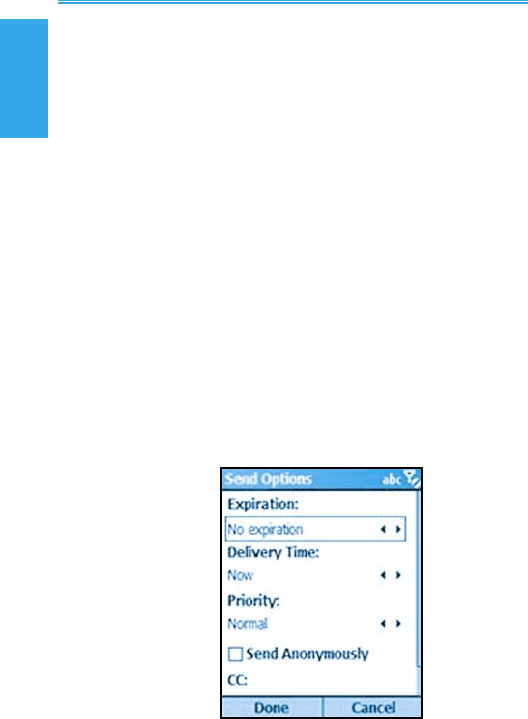
6. Messaging
features
Smartphone User Manual
120
6. Messaging
features
Smartphone User Manual 121
To access these additional options, press the Right Softkey
to open the menu:
Insert Object — Insert a picture/video, audio track, or text
into the current slide. This works the same as doing it on
the slide directly.
Capture — Take a picture, or record video or audio, and
attach the newly-captured le to your MMS message.
Clear Picture/Video/Text/Audio — Removes the selected
photo/video/text/audio le from the message.
Slides — Add, remove, or jump to the next/previous slide.
You can also adjust the duration of the current slide.
Template — Choose New From Template to create a
message with pre-set content. Choose Save As Template
to save your current message as a new template.
Send Options — Set the expiration, delivery time, and/or
priority of your message. You can also choose to send
the message anonymously and enter recipients to send
copies to.

6. Messaging
features
Smartphone User Manual
120
6. Messaging
features
Smartphone User Manual 121
Preview Message — “Plays” your message so you can see
what the recipient will see.
Send Message — Sends the message.
Cancel — Cancels the creation of the message.
This command only appears on the menu when you are
in the To eld:
Recipients — Choose Add to add recipients from your
address book, or Clear All to remove any recipients you
may have already added.
This command only appears on the menu when you are in
the Subject eld:
Edit Subject — Choose Canned Text to add a previously
saved text string to your subject, or Clear to erase the cur-
rent Subject text.
Viewing MMS messages
When previewing a message you are creating, or when
viewing a message in one of your folders, you can press
the Left Softkey to Pause or resume Playback of the mes-
sage. Or, you can press the Right Softkey to open the
menu, which contains:
Stop/Play — Stops or resumes message playback.
Object View — Displays a list view of the various message
components. Highlight a component and press Open to
view it. The menu accessed from the Object View screen
lets you open, save, or view info about that component.
Next — Jumps to the next slide, if any.
Previous — Jumps to the previous slide.
When the message has completed playback, you will see a
list of various message info. Press Done to exit.

6. Messaging
features
Smartphone User Manual
122

Chapter 7
Synchronizing
7.1 Using ActiveSync
7.2 Installing ActiveSync
7.3 Server ActiveSync
7.4 Other information

Smartphone User Manual
7.
Synchronizing
Smartphone User Manual
7.
Synchronizing
124
125
7.1 Using ActiveSync
Maintaining a steady connection between your Smartphone
and your desktop or notebook PC is essential. This process
of sharing information is called "synchronization." Active-
Sync synchronizes information stored on your Smartphone
from your PC or Microsoft Exchange Server. It also allows
you to share les between your Smartphone and your PC.
When you synchronize, ActiveSync compares the infor-
mation on your Smartphone with the information on your PC
and/or Exchange Server and updates all locations with the
most recent information.
With ActiveSync, you can:
• Keep your Outlook information up-to-date by synchroniz-
ing your Smartphone with your PC.
• Maintain connection with your Inbox, Calendar, and Con-
tacts with a server so that you have the latest information,
even when your computer is turned off.
• Copy (rather than synchronize) les between your Smart-
phone and your PC. Installation of new Smartphone software
applications/utilities are done through ActiveSync.
• Have control over when synchronization occurs by select-
ing a synchronization schedule.
• Select which types of information are synchronized, and
specify how much information is synchronized. For example,
you can choose how many weeks of past appointments to
synchronize.
• Using Server ActiveSync, you can synchronize informa-
tion directly with a Microsoft Exchange Server if your com-
pany is running Microsoft Mobile Information Server.

Smartphone User Manual
7.
Synchronizing
Smartphone User Manual
7.
Synchronizing
124
125
7.2 Installing ActiveSync
Before synchronization can begin, you must install Active-
Sync 3.7 or above on your desktop or notebook PC. Use
the Companion CD that came with your device, or install
ActiveSync for free by downloading the software from Micro-
soft's web site at http://www.microsoft.com/windowsmobile.
ActiveSync is already installed on your phone.
Creating a partnership
After the ActiveSync installation is completed, the New Part-
nership wizard will help you set up a partnership between
your Smartphone and your desktop or notebook PC. Your
rst synchronization process will automatically begin when
you nish using the wizard. After the rst synchronization,
you will notice that the information from your PC that you
selected now appears on your Smartphone. Before setting
up ActiveSync, connect the device to your computer using
a USB port, or via infrared connection.
Selective synchronization
The rst synchronization begins automatically after you nish
using the New Partnership wizard.
By default, ActiveSync does not automatically synchronize
all Outlook information. You can use ActiveSync options
to turn synchronization for specic information types on
and off:
1. On your PC, open the Microsoft ActiveSync program.
Click on Options.
2. By default, Calendar, Contacts, Tasks, and Inbox will
be synchronized. De-select the check box for the item (s)
you do not want to synchronize.
3. To adjust the settings for a particular type of information,
click on the type and then select Settings. For example,
you may select which folders in Inbox to synchronize.

Smartphone User Manual
7.
Synchronizing
Smartphone User Manual
7.
Synchronizing
126
127
7.3 Server ActiveSync
Before synchronizing information with a server, make sure
all the requested server authentication information such as
username, password, and the name of the Microsoft Mobile
Information Server are correct. In the New Partnership
wizard, select Synchronize with Microsoft Mobile Infor-
mation Server and/or this PC, instead of Synchronize
with this PC.
To set up Server ActiveSync:
1. In the Home screen, press the Start softkey, then select
ActiveSync from the list of programs.
2. Select Menu and then Options.
3. Select Server Settings, and then Connection.
4. In User name, enter your Microsoft Exchange user
name.
5. In Password, enter your Microsoft Exchange password.
6. In Domain, enter the name of the domain of your
Exchange server (if required).
7. If you want the device to save your password so that
you need not enter it when connecting, select Save
password.
8. If conguring a Server Name, enter the name of your
Exchange server.
9. Select Done. To begin synchronizing with the server,
press the Sync softkey.
To change server synchronization settings:
First, disconnect your phone from the PC. In your Smart-
phone's Home screen, select Start > ActiveSync. In the
ActiveSync screen, open the menu and select Options >
Server Settings. Select synchronization settings to edit Cal-
endar, Contacts, or Inbox; change the amount of information
to be synchronized. To synchronize the information, select
the Sync [Information Type] with a server checkbox on
the appropriate synchronization settings page.

Smartphone User Manual
7.
Synchronizing
Smartphone User Manual
7.
Synchronizing
126
127
Scheduling server synchronization
You can create a schedule for automatically synchronizing
information on your phone with your PC or with a Microsoft
Exchange Server. To set up a synchronization schedule
with your PC, you must use ActiveSync on the PC. For
instructions, see Change desktop synchronization schedule
in ActiveSync Help on the PC.
To set up a synchronization schedule with an Exchange
server, you must use ActiveSync on your Smartphone.
You can schedule synchronization of your device on two
separate schedules:
Peak times schedule: To synchronize during working hours
or other times you experience higher mail volumes.
Off-peak schedule: To synchronize during times when you
experience lower mail volumes. When you are roaming, you
can synchronize manually to reduce roaming charges, or you
can synchronize using the mobile schedules.
1. To edit schedule settings, your Smartphone must be
disconnected from your PC. On your Smartphone's
Home screen, select Start.
2. Select ActiveSync.
3. Select Menu and then Options.
4. Select Mobile Schedule.
a. Select how often to synchronize in the Peak time sync
list.
b. Select how often to synchronize in the Off-peak time
sync list.
c. Select whether or not to synchronize on a schedule in
the Roaming sync list.
d. Select Sync outgoing items as they are sent to
synchronize every time you send E-mail.
5. Select Done.

Smartphone User Manual
7.
Synchronizing
Smartphone User Manual
7.
Synchronizing
128
129
If you create a schedule for synchronizing while connected
to a PC as well as a schedule for synchronizing remotely
(wirelessly), the phone synchronizes according to both
schedules.
Synchronizing Automatically
With ActiveSync you can schedule automatic synchro-
nization between your device and a server every time an
item arrives or is changed at the server. Your device is
informed of that event and synchronizes automatically to
retrieve those items, making your device always up-to-date.
You must synchronize your device at least once (such as after
creating a partnership) before you can see and change the
settings for synchronization as items arrive.
NOTE: You can synchronize as items arrive, only if your
company or service provider is running Microsoft Exchange
Server with Exchange ActiveSync.
Scheduling synchronization
1. In your Smartphone's Home screen, select Start.
2. Select ActiveSync.
3. Select Menu and then Options.
4. Select Mobile Schedule.
5. Set Peak time sync and/or Off-peak time sync to As
items arrive.
6. Select Done.

Smartphone User Manual
7.
Synchronizing
Smartphone User Manual
7.
Synchronizing
128
129
7.4 Other information
Remote synchronization
Remote synchronization is when your device is synchronizing
over a wireless connection instead of using a direct local con-
nection to a desktop computer. Synchronizing remotely with
your desktop computer may depend on your network congu-
ration. For example, you may need to set up a virtual private
network (VPN) connection to your network.
To synchronize remotely, you need to set up a connection
rst. Then congure your Smartphone. In the ActiveSync
window, select Options > PC Settings from the menu: In
Use, select the computer name. Then select or clear Use
mobile schedule to sync with this PC, and Sync with this
PC during manual sync.
Synchronizing Inbox
When you select Inbox for synchronization in ActiveSync,
E-mail messages are synchronized as part of the general
synchronization process. During synchronization, the fol-
lowing events occur:
• Messages are copied from the Outlook Inbox folder on
your PC, or from Microsoft Exchange Server, to the Inbox
folder on your phone.
• By default, when synchronizing Inbox information with
your PC or Microsoft Exchange Server, you receive only
messages from the last 3 days and the rst 500 bytes of
each new message.
• The messages on your Smartphone and on your PC are
linked. When you delete a message on your phone, it is
deleted from your PC the next time you synchronize, and
vice versa.
• Messages in subfolders of other Outlook E-mail folders
are synchronized only if the folders have been selected
for synchronization in Inbox on your Smartphone.

Smartphone User Manual
7.
Synchronizing
130
NOTE: SMS messages are not received in Messaging
through synchronization. Instead, they are sent to your
Smartphone by way of your cellular service provider.
Synchronizing Calendar
When you select Calendar for synchronization in Active-
Sync, by default Calendar items from the last two weeks are
synchronized. Calendar items created on your Smartphone
are copied to your desktop computer and/or server during syn-
chronization, and vice versa. Similarly, Calendar items that
are deleted from your Smartphone are deleted from your PC
and/or server during synchronization, and vice versa.
Synchronizing Contacts
When you select Contacts for synchronization in ActiveSync,
by default all of your contacts are synchronized. Contacts
created on your Smartphone are copied to your PC and/or
server during synchronization, and vice versa. Similarly,
contacts that are deleted from your Smartphone are deleted
from your desktop computer and/or server during synchro-
nization, and vice versa.
Synchronizing Tasks
Task synchronization is automatically selected in ActiveSync.
By default, all of your incomplete tasks are synchronized.
Tasks created on your phone are copied to your desktop
computer during synchronization, and vice versa. Similarly,
tasks that are deleted from your phone are deleted from your
desktop computer during synchronization, and vice versa.
NOTE: Tasks can be synchronized only with your desktop
computer; they cannot be synchronized with a server.
ActiveSync error messages
If your information cannot be successfully synchronized, you
will see an error message on your Smartphone. To view
more information about the error, scroll to it and press the
Action key. You might also want to consult "Synchronizing In-
formation" in ActiveSync Help on your desktop computer.

Chapter 8
Applications
8.1 Using Contacts and Beaming
8.2 Using Calendar
8.3 Using Tasks
8.4 Using Voice Notes
8.5 Using Windows Media Player
8.6 Using Calculator
8.7 Using JAVA MIDlet Manager
8.8 Games

Smartphone User Manual
8.
Applications
Smartphone User Manual
8.
Applications
132
133
Microsoft Pocket Outlook includes Contacts, Calendar,
Tasks, Inbox/Messaging, and Voice Notes. You can use
these programs individually or together. For example, E-
mail addresses stored in Contacts can be used to address
E-mail messages in Inbox.
For information about Inbox and messaging, see Chapter
6, Messaging Features. The other applications in Pocket
Outlook mentioned above are explained on the next several
pages.
Using ActiveSync, you can synchronize information in
Microsoft Outlook or Microsoft Exchange on your PC with
your Smartphone. You can also synchronize this information
directly with a Microsoft Exchange server. Each time you
synchronize, ActiveSync compares the changes you made
on your Smartphone, and PC or server, and updates both
with the latest information.
For information about using ActiveSync, see Chapter 7.

Smartphone User Manual
8.
Applications
Smartphone User Manual
8.
Applications
132
133
8.1 Using Contacts and Beaming
You can think of Contacts as an online address book, where
you can store information about people and businesses you
communicate with in contact cards. For example, you can
store multiple phone numbers, E-mail and street addresses,
Web pages, birthday, anniversary date, etc. You can use
Contacts to dial phone numbers and compose E-mail and
SMS messages directly from a contact card.
The Contact list
The Contacts list displays the names of your contacts alpha-
betically, along with an abbreviation for the default communi-
cation method, such as the person's work phone number (w)
or home phone number (h). This makes it easy to reach the
contact using the method you prefer. Note that if the contact
entry includes a work phone number, your Smartphone will
automatically set it as the default number.
To access Contacts:
Select Contacts from the Start menu, or press the Right
Softkey (“Contacts”) when in the Home screen. The list of
Contacts will appear, as shown in the example below.

Smartphone User Manual
8.
Applications
Smartphone User Manual
8.
Applications
134
135
The following table shows some of the abbreviations that might be
displayed in the Contacts list, and their meanings.
Abbreviation Meaning
w Work phone
w2 Second work phone
wfx Work facsimile
h Home phone
h2 Second home phone
m Mobile phone
pgr Pager
car Car phone
txt Text message number
e E-mail address
e2 Second E-mail address
e3 Third E-mail address
web Web page
To call a contact using the default number:
1. Select Contacts from the Start menu, or press the Right
Softkey (“Contacts”) when in the Home screen. The list
of Contacts will appear.
2. Select the contact you want to call.
3. Press the Talk button. Your Smartphone will dial the
contact's default phone number. The abbreviation for
this number appears to the right of the contact name.

Smartphone User Manual
8.
Applications
Smartphone User Manual
8.
Applications
134
135
NOTE: If you want to change the default number, select the
desired Contact entry and press the Action button. Then
select the number you want to assign as the default, and
select Set as Default from the menu.
To call a contact using a number other than the default
number:
• Select the contact in the list, press the Left or Right
navigational buttons to display the abbreviation for the
number you want to use, then press the Talk button.
To nd a contact by entering a name:
• Begin entering the name of the contact to nd until the
name is displayed. For example, to nd "Sandra," enter
7, 2, 6, 3, 7, 2 because these numbers correspond to the
letters for that name.
To lter contacts:
• Select Filter from the menu, then select the category
whose entries you want to display, such as Business,
Miscellaneous, or Personal. Only the contacts assigned
to the category you select are displayed in the list.
To create a new contact:
• When the Contacts list is displayed, press the Left Softkey
(“New”), or select New Contact from the menu. After
entering the desired data, press Done.
To delete a contact:
• Select the desired entry in the Contacts list, then select
Delete from the menu.
To assign a Photo ID to a contact:
• Use the Photo Contacts (Caller ID) application. This was
explained earlier in Chapter 2.

Smartphone User Manual
8.
Applications
Smartphone User Manual
8.
Applications
136
137
Contact cards
To view a “contact card,” select the desired contact in the
list and press the Action button. A contact card displays all
of the information that you have entered for that contact.
You can use the menu to add it to your Speed Dial, send
a text message, save it to your SIM card, set the selected
number as the default number, beam the Contact, delete
it, or edit it.
To view and edit an existing contact card:
• Select the desired entry from the Contact list. Press the
Action button to view the contact card. If you wish to
modify it, press the Left Softkey (“Edit”) or select Edit from
the menu.
To call a contact from a contact card:
• Select the desired entry from the Contact list. Press the
Action button to access that contact card. Press the Up or
Down navigational button to select the number you want
to call, then press the Action button to dial that number.

Smartphone User Manual
8.
Applications
Smartphone User Manual
8.
Applications
136
137
To send E-mail from a contact card:
1. Select the desired entry from the Contact list.
2. Press the Action button to open the related contact card.
3 Select the E-mail address, and press the Action button.
4. Select an account to use, and press the Action button.
5. Enter a subject, compose your message, and then select
Send.
Using contact card menu options
Select the desired contact in the list, then press the Action
button to access the related contact card (shown in the gure
on the previous page). Using the menu accessed from that
screen, you can perform the functions listed below.
Add Speed Dial
Enables you to create a shortcut to a phone number, E-mail
address, or Web URL by assigning one or two numbers as a
speed dial. (Explained in more detail in Chapter 2.)
Send Text Message
Enables you to send a short message to the contact per-
son.
Add Voice Tag
After recording a Voice Tag, it serves as a shortcut to a phone
number, E-mail address, or Web URL when you speak the
Voice Tag. (Explained in more detail in Chapter 2.)
Save to SIM
Saves the contact to the SIM card.
Set as Default
Makes the selected phone number or E-mail address the
default communication method for the contact.
Beam Contact
Sends the contact card to another mobile device or a desktop
PC using infrared.

Smartphone User Manual
8.
Applications
Smartphone User Manual
8.
Applications
138
139
Delete
Removes the contact card from the Contacts list.
Edit
Enables you to modify information in the contact card.
Beaming information
You can use the Bluetooth or infrared port on your Smart-
phone to send and receive (beam) contact information
between your phone and another mobile device or a PC
that has Bluetooth or an infrared port and supports vCards
and vCal. However, you cannot beam SIM contacts. See
Chapter 5 for more information about Bluetooth.
To beam a contact:
1. Select Contacts from the Start menu.
2. Select the Contact entry you want to beam.
3. Select Beam Contact from the menu in the Contacts
screen.
4. Scroll to the device to which you want to beam.
5. Do one of the following:
• To beam by infrared, make sure that the infrared
ports are unobstructed and within close range of each
other.
• To beam by using Bluetooth, make sure that both
Bluetooth radios are turned on and that Bluetooth is
discoverable on the receiving device.
6. Press the Left Softkey (“Beam”).
Status information will then be displayed, indicating the
name of the device to which your Smartphone is beaming,
and whether the beaming process is pending, nished, or
has failed.

Smartphone User Manual
8.
Applications
Smartphone User Manual
8.
Applications
138
139
To receive beamed information:
1. Select Settings from the Start menu.
2. In the Settings screen, select Beam.
3. Select the Receive incoming beams checkbox so that
the checkbox is checked.
4. Do one of the following:
• To receive by infrared, align the infrared ports so that
they are unobstructed and within close range of each
other.
• To receive by using Bluetooth, make sure your
Bluetooth radio is turned on and in discoverable
mode.
5. Select Done. Your phone is now capable of receiving
beams (until you clear the Receive incoming beams
checkbox).
NOTE: Your Smartphone can receive beamed les of any
type, but you may need to copy some les to your PC for
viewing.
SIM contacts
SIM contacts are stored on your SIM card. When you insert
your SIM card into a different device, you can view and
use the SIM contact information on the new device. Unlike
regular contact cards, you can store only one phone number
for each SIM contact.
To create a new SIM contact:
1. Select Contacts from the Start Menu, or press the Right
Softkey (“Contacts”) in the Home screen.
2. Open the menu and select New SIM Contact.
3. Enter the Name and Number, then select Done.
The new contact appears in your contact list. A SIM icon will
display to the right of the name, indicating that the contact
is stored on your SIM card.

Smartphone User Manual
8.
Applications
Smartphone User Manual
8.
Applications
140
141
8.2 Using Calendar
Calendar is the scheduling program on your Smartphone,
where you can create and view appointments and view your
calendar by day, week, or month. When you create and
edit appointments in Calendar, your changes are reected
in Outlook on your PC when you synchronize.
To open Calendar:
• On the Home screen, select Calendar from the Start
menu.
To create a new appointment:
1. In the Calendar screen, select New from the menu.
2. Enter information about the appointment.
When inputting a Calendar entry, note that in the Reminder
eld you can specify the amount of time prior to the ap-
pointment that you want to be reminded. If you don't want
to be reminded, select None. The default reminder time is
15 minutes. If you want to change the reminder time later,
open the desired Calendar entry and then press the Left
Softkey (“Edit”), or select Edit from the menu in the Calendar
screen, and scroll to the Reminder eld.
When you create a new appointment on your Smartphone,
you can synchronize Calendar with your PC or Exchange
Server to keep your schedule information up-to-date in all
locations.

Smartphone User Manual
8.
Applications
Smartphone User Manual
8.
Applications
140
141
To edit an appointment:
1. Select Calendar from the Start menu.
2. Select the desired appointment, press the Action button,
and then select Edit from the menu or press the Left
Softkey (“Edit”).
3. If the appointment is recurring, select Yes to edit only the
current occurrence, or select No to edit the series.
4. Make your changes and select Done.
To delete an appointment:
1. Select Calendar from the Start menu.
2. Scroll to the appointment to delete.
3. Select Menu and then Delete.
4. If the appointment is recurring, select Yes to delete only the
current occurrence, or select No to delete the series.
Viewing your schedule
You can view your schedule in three different views: Agenda,
Week, and Month.
Agenda View is the default view for calendar information.
This view displays meetings and appointments scheduled
for the current day. Appointments are shown in chronologi-
cal order according to start time. All-day appointments are
shown as a single line at the top of the Agenda view.
When in Agenda View, you can select Week View or Month
View from the menu. Press the Left or Right navigational
buttons to select a desired date/time, then press the Action
button to view the corresponding entries, if any. Or, use the
menu to Go to Today, Go to Date, set Options, or return
to the default Agenda View.

Smartphone User Manual
8.
Applications
Smartphone User Manual
8.
Applications
142
143
Note that in Month View, arrows pointing upward represent
morning appointments, and arrows pointing downward rep-
resent afternoon appointments. If you have both morning
and afternoon appointments on the same day, the arrows
form a colored box. All-day events are indicated by an empty
box. If you have morning and afternoon appointments and
an all-day event on the same day, an empty box surrounds
a colored box.
Customizing the calendar view
You can change viewing options for Calendar, such as
specifying the rst day of the week and the number of days
per week to display, as well as showing and hiding week
numbers.
1. In the Home screen, select Start.
2. Select Calendar.
3. Select Menu and then Options.
4. Scroll to select the options you want and select Done.
Importing calendar information
You can import calendar information from another calendar
program that uses the iCal or vCal format. You can import
calendar information from attachments in E-mail messages,
SMS messages, and links in Microsoft Pocket Internet Ex-
plorer, or by beaming. When you import information and
then synchronize, the information is added to Outlook on
your PC.

Smartphone User Manual
8.
Applications
Smartphone User Manual
8.
Applications
142
143
8.3 Using Tasks
A task is a personal or work-related project, assignment,
or errand to track through to completion. A task can occur
once, or it can recur. A recurring task can repeat at regular
intervals, or repeat based on the date you mark the task
complete.
The task list
The task list is your "things to do" list. When you create or
edit tasks with Outlook on your PC and then synchronize with
your Smartphone, additional task information may display.
A task that has been marked as high priority is preceded by
an exclamation mark, and one marked as low priority by a
downward-pointing arrow. On color devices, overdue tasks
are displayed bold and red.
Note that if you synchronize tasks with your PC, completed
tasks are removed from your phone during synchroniza-
tion. They are then displayed in gray with a strikethrough
on your PC.
To create a new task:
• Select Tasks from the Start Menu. “Enter new task here”
is displayed. Press the Up navigational button to move
the focus to that eld, then enter the task name and press
the Action button.
To mark a task as Complete:
• Select Tasks from the Start Menu. Select the desired task
in the list (one whose checkbox is not checked) and then
press the Left Softkey (“Complete”).
To change a completed task to Incomplete:
• Select Tasks from the Start Menu. Select the desired task
in the list (one that has already been marked as Complete
with a checked checkbox) and then press the Left Softkey
(“Activate”).

Smartphone User Manual
8.
Applications
Smartphone User Manual
8.
Applications
144
145
8.4 Using Voice Notes
You can use Voice Notes to create and play back short voice
recordings and verbal reminders, in lieu of entering text, us-
ing your Smartphone’s built-in audio recorder. Voice Notes
are included in the All Notes list and are named consecutively
(Recording1, Recording2, and so on).
To create a Voice Note:
1. Select Voice Notes from the Start menu, or hold down
the Volume Up button for about three seconds (on the left
side of your phone). The All Notes screen displays.
2. Press the Left Softkey (“Record”), or select Record
from the menu. Right after you do this, the recording
process begins, so be ready to start speaking into your
Smartphone’s microphone immediately. A counter displays
the number of seconds elapsed during recording.
3. Press the Left Softkey (“Stop”) to stop recording a
voice note. The voice note is saved (to \Storage\My
Documents\Notes), and appears in the All Notes list
of Voice Notes. By default, the rst recording is named
Recording1.
To rename, play, or delete a Voice Note:
• Select the desired Voice Note le, then select either
Rename, Play, or Delete from the menu.
If you delete a voice note that has a default name, such as
Recording1, this name becomes available for the next new
voice note that you create.
NOTES:
• Voice Note les will be shown as thumbnails in the Album
(Camera Wizard) application, and you can play them as
you would any other audio le while in Album mode.
• You can also record a new voice note using the Album
application. While in Thumbnail View mode, select New
> Voice Note from the menu.

Smartphone User Manual
8.
Applications
Smartphone User Manual
8.
Applications
144
145
8.5 Using Windows Media Player
Using Windows Media Player 7.0 or later, you can play
Windows Media audio and video les and MP3 audio les
on your Smartphone. You can also copy digital music and
video directly from your PC to your phone by using either
Windows Media Player or Microsoft ActiveSync. For more
information about copying les using Windows Media Player,
see Media Player Help on your PC. For more information
about copying les using ActiveSync, see ActiveSync Help
on your PC.
Invoking Media Player and playing a le
When in the Home screen, open the Start menu and select
Windows Media. The initial Media Player screen will dis-
play a Playlist. The gure below lists some sample MP3
audio les.
By default, les of the supported letypes residing locally in
the phone are listed. Select the le you want to play, then
press the Action button or the Left Softkey (“Play”). Or, open
the menu to display a “Favorites” list, open a URL, view data
about the selected le, customize settings, or delete the le
(see table on next page).

Smartphone User Manual
8.
Applications
Smartphone User Manual
8.
Applications
146
147
When playback of an audio or video le is in progress, the
menu contains the following options:
Option Function
Play/Pause Play or pause playback of the cur-
rent le.
Next Skip to the next le in the current play
list and start playing it. This command
is not available if the last le is the cur-
rent selection.
Previous Skip to the previous le in the play list.
If a le is currently being played, it will
start re-playing from the beginning.
Full Screen If the le currently being played is a
video le, this option utilizes your en-
tire Smartphone screen to display the
video. This command is not available
during audio le playback.
Open URL Play a streaming media le on a net-
work (for example, content streamed
from an Internet radio station.)
Properties Displays information about the se-
lected le, such as le name, duration,
location, bit rate, and audio codec.
Settings Opens the Settings screen, in which
you can adjust the volume and specify
various playback options.
Add to Favorites Adds the le that is playing to your
Favorites playlist.

Smartphone User Manual
8.
Applications
Smartphone User Manual
8.
Applications
146
147
Selecting Settings on the menu opens a screen that lets
you:
• Adjust the volume. Press the Right navigational button
to increase the volume, up to a maximum of 10. Press
the Left button to decrease volume; 0 is silent.
• Specify whether or not to utilize the full phone screen
during playback of video les using Media Player.
• Select Repeat if you want Media Player to automatically
repeat playback of a le as soon as it nishes playing.
• Select Shufe if you want Media Player to randomly select
the next le to play from the current playlist.
• Select Background Play if you want les to continue
playing while you use another program.
As shown in the gure above, the amount of time elapsed
during playback is displayed. In this screen, you can press
the Up navigational button to increase volume, or press
Down to decrease volume. Press the Right navigational
button to start playing the next sequential le, or press Left
to play the previous le. Press the Action button to Pause
or Play.

Smartphone User Manual
8.
Applications
Smartphone User Manual
8.
Applications
148
149
To play a streaming media le on a network, open the
menu in the Windows Media Player screen, then select Open
URL. In the Open URL screen, enter the desired Web page
address. Press the Left Softkey (“Play”) to play.
To add a streaming media le to Favorites, simply open
the menu while it is playing, and select Add to Favorites. To
access your Favorites list, select Favorites from the menu
in the Media Player window. To delete a le from Favorites,
select the le and then select Delete from the menu. To play
a le, select Play.
Supported le formats
Windows Media Player supports the MP3 (.mp3) le format,
as well as Windows Media les with the following extensions:
.asf, .asx, .wax, .wm, .wma, .wmv, .wmx, .wvx.
Supported audio and video codecs
Media Player can play les that have been compressed by
using any of the following audio and video codecs.
Audio codecs:
• Microsoft Windows Media Audio codec version 2.0,
7.0, 8.0, and 9.0.
* Fraunhofer IIS-A MPEG-1 Audio Layer-3 codec.
Video codecs:
• Microsoft Windows Media Video codec version 7.0,
8.0, and 9.0.
• Microsoft MPEG-4 video codec version 3.0.
• ISO MPEG-4 video codec version 1.0.
NOTE: Some digital media content from the Internet, CD
tracks, and videos have associated licenses that protect
them from being unlawfully distributed or shared. To ensure
that the license is copied with the content, use the Portable
Device (or Copy to CD or Device) feature in Windows Media
Player 7.0 or later on your PC to copy content to your phone.
See also the Windows Media Player Help on your PC.

Smartphone User Manual
8.
Applications
Smartphone User Manual
8.
Applications
148
149
8.6 Using Calculator
Calculator performs basic arithmetic, such as addition,
subtraction, multiplication, and division.
To perform a calculation:
1. When in the Home screen, select Accessories from the
Start menu.
2. Select Calculator.
3. Enter the rst number of the formula using the keypad.
4. Press the Right Softkey (“Options”). From the menu
select the type of calculation to perform: Add, Subtract,
Multiply, Divide, or Decimal Point.
NOTES:
• A decimal point can also be inserted conveniently by
pressing the asterisk (*) key on your keypad.
• In addition, you can scroll through the available
mathematical symbols by pressing the # key until the
symbol you want is displayed (instead of selecting from
the menu).
• Or, you can use the navigation pad to select a
mathematical symbol as follows: Press the Up button
for the plus sign (+); Down for the minus sign (-); Left
for the division sign (/); and Right for the multiplication
sign (X).
5. Enter the second number of the formula using the
keypad.
6. Open the Options menu again and select Equals, or press
the Action button.
To clear a displayed number or calculation, press the
Left softkey (“Clear”).
To clear the last digit entered, press your phone’s Back
button.

Smartphone User Manual
8.
Applications
Smartphone User Manual
8.
Applications
150
151
8.7 Using Java MIDlet Manager
Your phone supports Java 2 Edition, J2ME. The Java MIDlet
Manager (JMM) allows you to download Java applications
such as games and tools specically designed for mobile
phones. You will nd that some Java applications and games
may have already been installed on your Smartphone. When
you select MIDlet Manager from the Start menu in the Home
screen, a screen similar to the example shown below will
appear. This gure also shows the main menu.
The Java MIDlet Manager gives you the exibility of install-
ing and managing additional J2ME applications from the
Internet.

Smartphone User Manual
8.
Applications
Smartphone User Manual
8.
Applications
150
151
Downloading Java games and utilities
To install, run, and manage MIDlet programs (MIDlets) on
your Smartphone, you have to rst download the MIDlet
directly to your device from your desktop or notebook PC.
To download and install MIDlets directly from the In-
ternet:
1. Connect to the Internet and select a MIDlet you wish to
download. (Download both the .jad le and related .jar
le.)
2. Conrm that you wish to download the relevant les before
the download begins. Once the download is complete,
the Java MIDlet Manager automatically starts and prompts
you to install your new MIDlet.
To download MIDlets from the Internet on your PC:
1. Make sure your Smartphone is synchronized to your PC.
Using your Internet Explorer, go to www.midlet.org or
any site that provides MIDlets for download.
2. Choose the game or utility you want to install, download
it, and save it to your hard drive.
3. Click on the le and move it to your Smartphone, to Mobile
Device\phone\Storage\My Documents.
To install MIDlets on your Smartphone from your PC:
1. Click on Install in the MIDlet Manager menu.
2. Choose a MIDlet available from the Install screen. Select
a MIDlet by moving up/down using the navigation pad, or
by pressing the related number on the keypad.

Smartphone User Manual
8.
Applications
Smartphone User Manual
8.
Applications
152
153
Uninstalling and re-installing MIDlets
To Uninstall
In the Java Apps screen (an example was shown in the pre-
vious gure), use the navigation pad to highlight the MIDlet
you want to uninstall, then select Manage from the menu.
Select Uninstall from the Manage submenu. You will be
asked to conrm your selection.
To Re-install:
In the Java Apps screen, select Install from the menu to ac-
cess the Install screen. Use the navigation pad to highlight
the MIDlet you want to re-install, then select Install from the
menu in the Install screen.
Running MIDlets
To run a MIDlet, go to the Java Apps screen and select
the required MIDlet using the navigation pad or the related
number on the keypad. Consult the content provider on
how to use the game or utility you have installed. Some
MIDlets have an Exit or Stop command within their menu
structure. The content providers determine the location of
this command.
Other menus and commands
Some of the other functions available include:
Settings
Select Settings from the menu to access these options:
Display Options — Allows you to adapt the way the MIDlet
manager displays information. Sort Options allows you
to choose whether you view your MIDlets in groups or as
a list. View Options allows you to determine how lists of
MIDlets are ordered.
System Info — Displays information about the total
storage space for MIDlets, the amount currently used
and the amount currently available.

Smartphone User Manual
8.
Applications
Smartphone User Manual
8.
Applications
152
153
About Java MIDlet Manager — Displays version
information.
Choose Network Type — Opens the Select Service
screen and enables you to choose your connection.
Rename
Select the MIDlet you want to rename, then enter the new
name for that MIDlet in the dialog box.
Running
Lists the MIDlet(s) currently running on your Smartphone.
Recent
Lists the most recently run MIDlets (maximum of nine can
be listed).
Move
Lets you move the selected item into a different group.
Manage > Upgrade
You may be able to upgrade certain MIDlets using a network
connection. The availability of this feature is determined by
MIDlet manufacturers/distibutors and their licensing arrange-
ments. You must be connected to an appropriate network for
this feature to be available, for example a corporate intranet
or the Internet.
Manage > Uninstall
Deletes the selected MIDlet from your phone’s memory.
Ensure that the MIDlet you want to select is not running.
Also note that you cannot uninstall a MIDlet individually
from a MIDlet suite. You must uninstall the complete MID-
let suite.
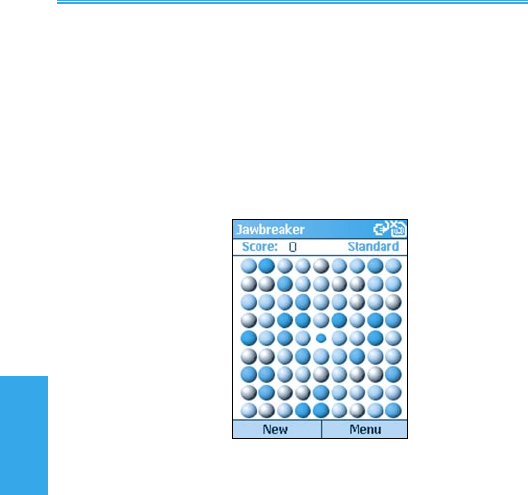
Smartphone User Manual
8.
Applications
Smartphone User Manual
8.
Applications
154
155
8.8 Games
Jawbreaker
The object of Jawbreaker is to clear out all the balls. The
rule is that you may only clear out adjacent same-colored
balls. The score depends on the number of the balls you
clear out at every move.
To start a game of Jawbreaker, select Games from the
Start menu, then select Jawbreaker. To start a new game,
press the Left Softkey, or select New Game from the menu.
The menu also lets you view Statistics or set Options.
To score, navigate to the ball you want to clear and press
the Action button.
Score equation: S = B * (B-1)
S: Score per move
B: Number of balls you clear out
For example, you score 30 points for clearing out 6 balls
at one move.

Smartphone User Manual
8.
Applications
Smartphone User Manual
8.
Applications
154
155
Solitaire
The object of Solitaire is to use all the cards in the deck to
build up the four suit stacks in ascending order, beginning
with the aces. You win the game when all cards are on the
suit stacks.
To start a game of Solitaire, select Games from the Start
menu, then select Solitaire. To start a new game, select
New Game from the menu.
To play Solitaire:
• Move any aces on the seven stacks to the four card spaces
at the top of the screen, and then make any other available
plays.
• When you have made all available plays, press the Draw
soft key to turn over cards.
The card that is face up on the deck is always available
for play.

Smartphone User Manual
8.
Applications
156
To move cards:
A number or character is displayed above each card stack.
On the keypad, press the number or character of the card to
move, and then press the number or character of the stack
to which you want to move the card.
Pressing the Up navigational button moves a card to one
of the four stacks in the upper right corner of the screen if
it belongs there. For example, if an ace appears in one of
the lower stacks, press the number above it, and then press
the Up navigational button.

Chapter 9
Maintaining Your
Smartphone
9.1 Adding and removing programs
9.2 File Manager
9.3 Task Manager
9.4 Space Maker

Smartphone User Manual
9. System
Maintenance
158
Smartphone User Manual
9. System
Maintenance
159
9.1 Adding and removing
programs
You can use Add/Remove Programs on the Tools Menu of
Microsoft ActiveSync to add and remove programs. If you are
connected via ActiveSync (see Chapter 7), and the program
you want to install has an installer le that can be executed
from the PC, installation will be performed automatically
when you invoke the Installer le on your PC.
If the program installation is done via a CAB le, copy
the CAB le to the \Storage\My Documents folder of your
phone. Then select it in File Manager (explained on the
next page) and press the Action button; it will then install
automatically.
If you do install additional programs into your Smartphone,
and then want to remove one or more of those programs,
another way to do so (besides Add/Remove Programs in
ActiveSync) is to select Settings from the Start Menu, and
then Remove Programs. All of the programs you’ve in-
stalled yourself will be listed in the Remove Programs screen.
Select the program you want to delete, then press the Right
Softkey to open the menu and select Remove.
NOTE: When you use the Clear Storage utility to reset
all of your Smartphone’s settings back to the manufacturer
default values, this will also erase all of your data.

Smartphone User Manual
9. System
Maintenance
158
Smartphone User Manual
9. System
Maintenance
159
9.2 File Manager
File Manager provides many easy-to-use features for le
and folder management. It operates in either of two major
views, with a separate menu of commands for each view.
Tree View displays the entire le structure in your Smart-
phone’s memory. The functions in Tree View primarily focus
on folder management.
List View displays the details of the selected folder (its sub-
folders and les). The functions in List View are basically
le-oriented.
Tree view
When initially invoked, File Manager is in Tree View by
default. An example is illustrated below.

Smartphone User Manual
9. System
Maintenance
160
Smartphone User Manual
9. System
Maintenance
161
Menu Commands in Tree View
Folder
Selecting Folder opens a submenu that lets you create a
New Folder which will be a subfolder under the current
folder; or Rename, Copy, or Move the currently selected
folder.
Find
This command lets you search for les according to lename
and/or text content. First select the folder where you want the
search to be executed, then select Find. The Find screen
will open. In it, enter part or all of a lename (if you wish
to search by name), and/or enter a text string (if you wish
to search for all les containing that string). You can also
specify the folder to be searched. If any matches are found,
the Find Result screen will open.
Go To
Allows you to switch to other folders conveniently. Shortcut:
press G (the 4 key on your Smartphone’s keypad) when the
menu is not open.
Delete
Allows you to delete an entire folder and all of its contents.
Shortcut: press D (the 3 key on the keypad) when the menu
is not open. To delete individual les, use Delete on the
menu when in List View.
Refresh
Re-paints the Tree View to reect the actual current contents
in memory. You can also press the asterisk (*) shortcut key
to update the screen.
Properties
Displays data related to the selected folder. (If you wish to
view information about an individual le, use the Properties
command in List View.)

Smartphone User Manual
9. System
Maintenance
160
Smartphone User Manual
9. System
Maintenance
161
Options
The Options screen contains several checkboxes that allow
you to customize certain behaviors of File Manager. For
example, you can choose to use a small font, show or hide
le extensions, show or hide les in ROM, etc. Select Reset
Default (on the menu in the Options screen) if you ever want
to reset all options to the default behavior.
System Info
The System Info screen displays useful information about
Battery power, Memory usage, Flash and Device data.
List view
If in Tree View, press the Left Softkey to switch to List View.
If the currently selected folder in Tree View contains no
subfolders, pressing the Action button will also switch to
List View. (If the selected folder in Tree View does have
subfolders, pressing the Action button expands or collapses
the tree for that folder.)

Smartphone User Manual
9. System
Maintenance
162
Smartphone User Manual
9. System
Maintenance
163
Menu Commands in List View
You can perform many additional le management func-
tions using the commands on the menu when in List View,
as follows:
File
Selecting File opens a submenu that lets you create a New
Folder which will be a subfolder under the current folder; or
Rename, Copy, Move, or Duplicate the currently selected
le(s).
Selecting Associate on the File submenu allows you to as-
sociate all les that have the same extension as the selected
le with a specic application program. Then whenever you
select a le of the associated letype, it will open using the
application you specied.
Even if a particular letype is already associated with a
particular application, you can perform a one-time override
of that default association using the Open With command
on the File submenu. It allows you to select a le, and then
individually select the application that you want to open the
le with.
Create Shortcut on the File submenu enables you to create
a shortcut for a le and place it in any folder. First select
the le for which you want to create a shortcut, then select
Create Shortcut and select the folder where you want it
to be placed.
Zip Extraction
This command lets you “unzip” (extract) ZIP les that you
may have received into your Smartphone via ActiveSync,
infrared beaming, E-mail, etc. First, select the desired le
(lename must have an extension of .zip). Then select Zip
Extraction. This opens a submenu containing the Contents
and Extract Here commands.

Smartphone User Manual
9. System
Maintenance
162
Smartphone User Manual
9. System
Maintenance
163
Select Extract Here from the submenu if you just want to
extract all the les immediately and place them in the cur-
rent folder.
Selecting Contents from the submenu will list all the les
contained in the selected ZIP le. In the screen listing the
individual les, you can open a menu containing several
options. Among them are:
Extract To — If you don’t want all les in the list to be
extracted, you can rst select only the les you want.
Then select the folder/subfolder where you want to place
the extracted les and press the Left Softkey (“Extract”).
Integrity Test — This command checks to see if the data
contained in all of the individual les (contained in the
current ZIP le) is correct.
View — This command is available when only one individual
le or one folder is selected. If an individual le within the
ZIP le is selected, then the View command invokes the
application associated with that letype and displays the
le. If the ZIP le contains folders, and one of the folders
within the ZIP le is selected, then the View command
will open the folder and display a list of the les within
it. A “plus sign” (+) will be shown in front of encrypted
items in a ZIP le.
Selection
The next command on the main menu in List View (after the
Zip Extraction command) is Selection. It opens a submenu
that lets you Go to Top, Go to End, Select All, Select None,
Invert Select, or enable Select Multiple if you want to select
more than one item in the list. In the Select Multiple screen,
the menu offers additional options to select only the folders
in the list, or only the les in the list.
Sort By
Lets you sort the items in the list by Name, Size, or Date,
in either Ascending or Descending order.

Smartphone User Manual
9. System
Maintenance
164
Smartphone User Manual
9. System
Maintenance
165
Send
This command opens a submenu containing two com-
mands:
Send via E-mail — Only one le can be E-mailed at a
time. (If multiple les are selected, this command will be
disabled.) First, select the le you want to E-mail, then
select this command. The Compose New screen will open
with the selected le already attached.
Send via Infrared — First, select one or more les that you
want to send, or an entire folder, then select this command.
In the Send Data screen that opens, press the Left Softkey
(“Beam”) to start beaming. After the les have nished
being sent, you can beam them again to another device,
if desired, by pressing the Left Softkey again (“Restart”).
Run
If the currently selected le is an executable program le,
selecting Run will invoke that application. Or, if you have
used the Associate command on the File submenu to as-
sociate a particular letype with a particular application,
selecting Run (when a le of that letype is selected) will
start the associated application. The Action button is the
shortcut key for this command.
Delete
Select the le or folder you want to delete, then select Delete
on the menu (or press D on your Smartphone’s keypad when
the menu is not open).
Refresh
When you select Refresh from the menu, or press the
asterisk (*) shortcut key on your keypad when the menu
is closed, the contents of the List View will be re-painted to
reect the actual current contents in memory.

Smartphone User Manual
9. System
Maintenance
164
Smartphone User Manual
9. System
Maintenance
165
Properties
If a le or folder is selected in the list at the time you select
Properties from the main List View menu, the Properties
screen will display related information. Also, in the bottom
portion of the screen, you can change some attributes of the
le or folder, and view others. (This command is disabled if
multiple les/folders are disabled.)
Options
The Options screen is the same one you can access from
the menu in Tree View. It contains several checkboxes that
allow you to customize certain behaviors of File Manager.
For example, you can choose to use a small font, show or
hide le extensions, show or hide les in ROM, etc. Select
Reset Default (on the menu in the Options screen) if you ever
want to reset all options to the default behavior.
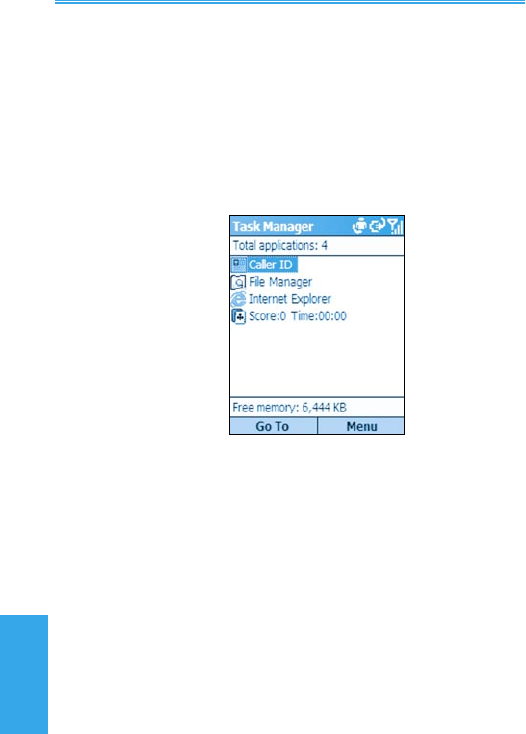
Smartphone User Manual
9. System
Maintenance
166
Smartphone User Manual
9. System
Maintenance
167
9.3 Task Manager
Task Manager lists all the tasks/applications currently run-
ning on your Smartphone. You can then easily switch to and
activate any currently running task, terminate any tasks, and
view free memory/battery information.
When Task Manager is initially invoked, it lists all tasks/
applications that are currently running in the memory of your
Smartphone. An example is illustrated below.
Menu Commands
Go To
This command activates the selected application/task. First,
select the application in the list that you want to use. Then
select Go To from the menu, or press the Action button, to
switch to that application and make it the active task. (You
can also use the Left Softkey to activate a task if the menu
is not open.)
Refresh
Selecting the Refresh command, or pressing the asterisk
(*) key on the phone keypad, will update and repaint the list
of currently running tasks.
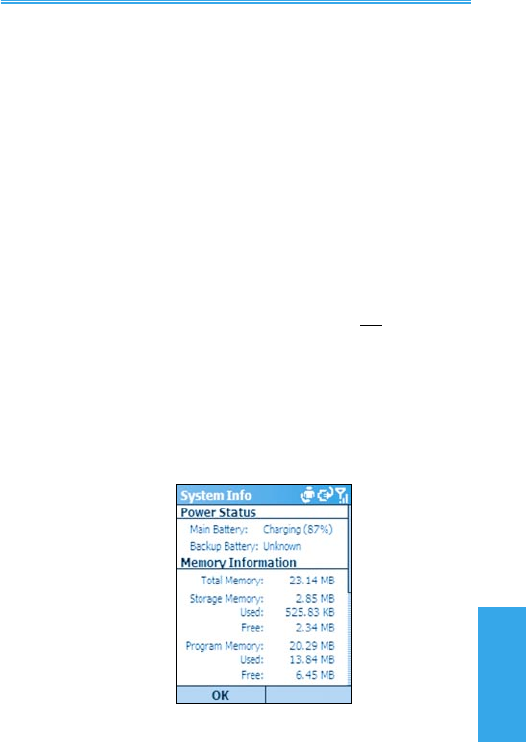
Smartphone User Manual
9. System
Maintenance
166
Smartphone User Manual
9. System
Maintenance
167
Stop
The Stop command (or the 7 key on your Smartphone’s
keypad, if the menu is not open) stops the selected ap-
plication. If for any reason the task cannot be terminated,
a message will inform you of such. After you have stopped
an application, the amount of Free Memory (shown near the
bottom of the screen) is updated.
Stop All
Selecting Stop All, (or pressing the 2 key if the menu is not
open), tells Task Manager to try to stop all the listed applica-
tions. A message will ask you to conrm that you want to
terminate all currently running applications. Press the Left
Softkey (“OK”) to conrm.
Stop All But Selected
First select the one task in the list that you do not want to stop.
Then select Stop All But Selected. All other running tasks
will then be terminated, except the one you selected.
System Info
Select System Info to view details concerning your Power/
Battery, Memory, Flash, and Device information. The il-
lustration below shows the upper half of a sample System
Info screen.
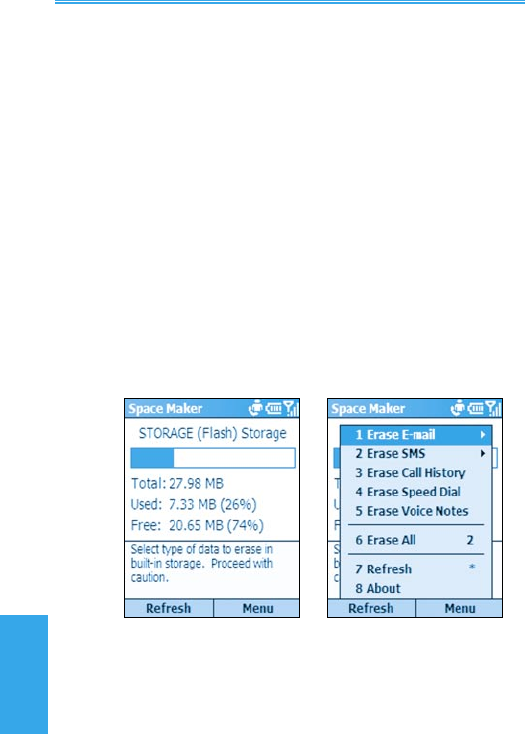
Smartphone User Manual
9. System
Maintenance
168
Smartphone User Manual
9. System
Maintenance
169
9.4 Space Maker
Your phone has a built-in, unremovable default storage
card. The nomenclature of the card is hardware-depen-
dent (in some phones it is known as “Flash” Storage). The
Smartphone uses this card to store certain data, such as
the data in your Contacts, Tasks, Appointments (Calendar),
and E-mail items. There are times when free storage space
might become low, at which time you might want to delete
any less-needed items in order to free up space.
Space Maker makes it easy for you to delete specic cat-
egories of any unwanted data in Flash storage as you see t,
thereby letting you control the amount of space available.
The main Space Maker screen, shown below on the left,
displays the total amount of space available in your particular
built-in storage, the amount of space currently being occupied
by your data on the card (and percentage) and the amount
of space currently not being used (and percentage).
Keypad shortcuts: When the menu is not open, you can
press the 2 key to invoke the Erase All command, or press
the asterisk (*) key to update the storage usage data to reect
the current “Used” and “Free” amounts.

Smartphone User Manual
9. System
Maintenance
168
Smartphone User Manual
9. System
Maintenance
169
Menu Commands
Erase E-mail
Selecting Erase E-mail will open a submenu that gives you
the exibility to delete all E-mail; or only the E-mail marked
as “Read;” or only the E-mail in these individual folders:
Deleted Items, Drafts, Inbox, Outbox, or Sent Items.
Deleting All E-mail — Select All to delete all E-mail in all
folders. All attachments will also be deleted. Note that
SMS and MMS messages will not be deleted. (If you wish
to delete SMS messages in your Inbox, use the Erase SMS
command described on the next page.)
After you select All from the submenu, a conrmation screen
will appear. It displays the number of E-mailings that will
be deleted, and the amount of space currently being used
by those E-mailings which will be “freed up” in your Flash
storage after the command has executed. Press the Left
Softkey to Conrm, or the Right Softkey to Cancel.
After the “Delete All E-mail” operation has nished, all E-mail
will be deleted from the phone. Therefore, the next time you
synchronize after deleting, your E-mail will be out-of-sync,
since it will be gone from your Smartphone but will still exist
on your PC. If you want E-mail to be synchronized on both
phone and PC, rst delete your current partnership and then
create a new partnership.
Deleting Individual Categories of E-mail — Likewise, you
can select one of the following commands from the submenu
to delete only the E-mail in those categories: Read (deletes
all E-mail marked as “Read”); Deleted Items; Drafts; Inbox;
Outbox; and/or Sent Items. In each case, a screen will
open which displays the number of items in that category,
and the total space being used by those items (similar to the
example illustrated on the next page).

Smartphone User Manual
9. System
Maintenance
170
Smartphone User Manual
9. System
Maintenance
171
Erase SMS
The Erase SMS command opens a submenu that gives you
a choice of deleting all SMS (Short Message Service) mes-
sages, or only the messages marked as “Read.” Whether
you select All or Read from the submenu, a conrmation
screen will appear and display the number of SMS mes-
sages that will be deleted, as well as the amount of space
being used by those SMS messages. An example is shown
below. Press the Left Softkey (“Conrm”) to delete. You will
then be returned to the main Space Maker screen illustrated
earlier, and the new total “Used” and “Free” storage amounts
will be displayed.
Erase Call History
To delete all Call History data, select Erase Call History on
the menu. A conrmation screen will display the number of
Call History records that will be deleted, and the amount of
space currently being used by those records (similar to the
screen shown above). Press the Left Softkey to Conrm
that you want to delete all Call History records, or the Right
Softkey to Cancel.

Smartphone User Manual
9. System
Maintenance
170
Smartphone User Manual
9. System
Maintenance
171
Erase Speed Dial
To delete all Speed Dial entries, select Erase Speed Dial
on the menu. A conrmation screen will display the number
of Speed Dial records that will be deleted, and the amount
of space currently being used by that data. Press the Left
Softkey to delete, or the Right Softkey to cancel.
Erase Voice Notes
This command deletes all voice recordings you have cre-
ated and stored in Flash storage, using your phone’s Voice
Notes function. In the conrmation screen, press the Left
Softkey to delete.
Erase All
When you select the Erase All command from the menu (or
press 2 on your Smartphone’s keypad, when the menu is
not open), the screen shown below opens. It allows you to
conveniently select multiple categories of data that you want
to delete (rather than deleting categories of data one-by-one
using the individual commands on the main menu).
After checking the desired checkboxes, press the Left
Softkey to begin the Erase process. You will still be given
an opportunity to conrm the deletion of each category
individually.

Smartphone User Manual
9. System
Maintenance
172
Refresh
Selecting Refresh on the menu, or pressing the asterisk
(*) shortcut key, or the Left Softkey in the main screen,
updates and re-displays the amounts of Used Storage and
Free Storage.
Whenever you use any of the “Erase” commands on the
menu, the Refresh operation will be performed automati-
cally to show you the new storage amounts resulting from
the deletion.

Appendix
Regulatory Notices
Troubleshooting
Specications
Index

Smartphone User Manual
Appendix
Smartphone User Manual
Appendix
174
175
Regulatory Notices
Agency Identication Numbers
For regulatory identication purposes, your product is as-
signed a model number of ST20A. The Battery Pack has
been assigned a model number of ST26A.
To ensure continued reliable and safe operation of your
Smartphone, use only the accessories listed below with
your ST20A.
NOTE: This product is intended to be used with a certied
class 2 limited power source, rated 5 volts DC, minimum
1A power supply unit.
European Union Notice
Products with CE marking comply with the R&TTE Directive
(99/5/EC), the EMC Directive (89/336/EEC) and the Low
Voltage Directive (73/23/EEC) issued by the Commission
of the European Community.
Compliance with these directives implies conformity to the
following European Norms (in brackets are the equivalent
international standards):
§ EN 60950 (IEC 60950) - Safety of Information Technology
Equipment.
§ETSI EN 301 489-7 - Electromagnetic compatibility
and Radio spectrum Matters (ERM); ElectroMagnetic
Compatibility (EMC) for radio equipment and services;
Part 7: Specific conditions for mobile and portable
radio and ancillary equipment of digital cellular radio
telecommunications systems (GSM and DCS).

Smartphone User Manual
Appendix
Smartphone User Manual
Appendix
174
175
§ETSI EN 301 511 – Global System for Mobile
communications (GSM); Harmonized standard for mobile
stations in the GSM 850 and DCS 1800 bands covering
essential requirements under article 3.2 of the R&TTE
directive (1999/5/EC).
§ANSI/IEEE C.95.1-1992- specific absorption rate in
mobile phone emission condition for body health.
§FCC part 15 - Radio Frequency Devices and part 24
– Personal Communications Services.
§EN 50360 - 2001– Product standard to demonstrate the
compliance of mobile phones with the basic restrictions
related to human exposure to electromagnetic elds (300
MHz – 3 GHz).
§SAR: FCC: (1g) 1900MHZ: Body xxxxx mW/g; Head
xxxxx mW/g. CE: (10g) 850MHZ: Body xxxxx mW/g;
Head xxxxx mW/g. 1800MHZ: Body xxxxx mW/g; Head
xxxxx mW/g.
§ETSI EN 301 489-1 Electromagnetic compatibility
and Radio spectrum Matters (ERM); ElectroMagnetic
Compatibility (EMC) standard for radio equipment and
services; Part 1: Common technical requirements.
§ETSI EN 301 489-17 Electromagnetic compatibility
and Radio spectrum Matters (ERM); ElectroMagnetic
Compatibility (EMC) standard for radio equipment
and services; Part 17: Specific conditions for 2.4
GHz wideband transmission systems and 5 GHz high
performance RLAN equipment.
§ETSI EN 300 328 Electromagnetic compatibility and
Radio spectrum Matters (ERM); Wideband Transmission
systems; data transmission equipment operating in the
2.4 GHz ISM band and using spread spectrum modulation
techniques.

Smartphone User Manual
Appendix
Smartphone User Manual
Appendix
176
177
Federal Communications Commission
Notice
This equipment has been tested and found to comply with
the limits for a Class B digital device, pursuant to Part 15
of the FCC Rules. These limits are designed to provide
reasonable protection against harmful interference in a
residential installation. This equipment generates, uses,
and can radiate radio frequency energy and, if not installed
and used in accordance with the instructions, may cause
harmful interference to radio communications. However,
there is no guarantee that interference will not occur in a
particular installation. If this equipment does cause harm-
ful interference to radio or TV reception, which can be
determined by turning the equipment on and off, the user
is encouraged to try to correct the interference by one or
more of the following measures:
• Reorient or relocate the receiving antenna.
• Increase the separation between the equipment and
receiver.
• Connect the equipment into an outlet on a
circuit different from that to which the receiver is
connected.
• Consult the dealer or an experienced radio or
television technician for help.
Modications
The FCC requires the user to be notied that any changes
or modications made to the device that are not expressly
approved by High Tech Computer Corporation may void
the user’s authority to operate the equipment.
This device complies with Part 15 of the FCC Rules. Operation is subject to the
following two conditions:
(1) This device may not cause harmful interference.
(2) This device must accept any interference received, including interference that
may cause undesired operation.

Smartphone User Manual
Appendix
Smartphone User Manual
Appendix
176
177
Important Safety Information
Retain and follow all product safety and operating instruc-
tions. Observe all warnings on the product and in the
operating instructions.
To reduce the risk of bodily injury, electric shock, re, and
damage to the equipment, observe the following precau-
tions.

Smartphone User Manual
Appendix
Smartphone User Manual
Appendix
178
179
Use only original manufacturer-approved accessories,
or accessories that do not contain any metal: Use of
non-original manufacturer-approved accessories may
violate FCC RF exposure guidelines and should be
avoided.
Heed service markings: Except as explained elsewhere
in the Operating or Service documentation, do not service
any product yourself. Service needed on components in-
side these compartments should be done by an authorized
service technician or provider.
Damage requiring service: Unplug the product from the
electrical outlet and refer servicing to an authorized service
technician or provider under the following conditions:
• Liquid has been spilled or an object has fallen into
the product.
•The product has been exposed to rain or water.
•The product has been dropped or damaged.
•There are noticeable signs of overheating.
•The product does not operate normally when you
follow the operating instructions.
Avoid hot areas: The product should be placed away from
heat sources such as radiators, heat registers, stoves, or
other products (including ampliers) that produce heat.
Avoid wet areas: Never use the product in a wet loca-
tion.
Avoid pushing objects into product: Never push objects
of any kind into cabinet slots or other openings in the prod-
uct. Slots and openings are provided for ventilation. These
openings must not be blocked or covered.

Smartphone User Manual
Appendix
Smartphone User Manual
Appendix
178
179
Mounting Accessories: Do not use the product on an
unstable table, cart, stand, tripod, or bracket. Any mounting
of the product should follow the manufacturer’s instructions,
and should use a mounting accessory recommended by
the manufacturer.
Avoid unstable mounting: Do not place the product with
an unstable base.
Use product with approved equipment: This product
should be used only with personal computers and options
identied as suitable for use with your equipment.
Adjust the volume: Turn down the volume before using
headphones or other audio devices.
Cleaning: Unplug the product from the wall outlet before
cleaning. Do not use liquid cleaners or aerosol cleaners.
Use a slightly damp cloth for cleaning, but NEVER use water
to clean an LCD screen.
Safety Precautions for Power Supply
Unit
Use the correct external power source: A product should
be operated only from the type of power source indicated
on the electrical ratings label. If you are not sure of the
type of power source required, consult your authorized
service provider or local power company. For a product
that operates from battery power or other sources, refer to
the operating instructions that are included with the product.
Handle battery packs carefully: This product contains
a Lithium ion battery. There is a risk of re and burns
if the battery pack is handled improperly. Do not attempt
to open or service the battery pack. Do not disassemble,
crush, puncture, short external contacts or circuits, dispose
of in re or water, or expose a battery pack to temperatures
higher than 60°C (140°F).

Smartphone User Manual
Appendix
Smartphone User Manual
Appendix
180
181
Exposure to Radio Frequency (RF)
Signals
Your wireless phone is a radio transmitter and receiver. It
is designed and manufactured not to exceed the emission
limits for exposure to radio frequency (RF) energy set by the
Federal Communications Commission of the U.S. Govern-
ment. These limits are part of comprehensive guidelines
and establish permitted levels of RF energy for the gen-
eral population. The guidelines are based on the safety
standards previously set by both U.S. and international
standards bodies:
• American National Standards Institute (ANSI) IEEE.
C95.1-1992
• National Council on Radiation Protection and Measure-
ment (NCRP). Report 86. 1986
• International Commission on Non-Ionizing Radiation
Protection (ICNIRP) 1996
• Ministry of Health (Canada), Safety Code 6. The standards
include a substantial safety margin designed to assure the
safety of all persons, regardless of age and health.
IMPORTANT NOTE (CO-LOCATION)
FCC RF Radiation Exposure Statement: This equipment complies with FCC
RF radiation exposure limits set forth for an uncontrolled environment. This
device has been tested and demonstrated compliance when Bluetooth and
GSM / DCS are transmitting simultaneously. This PDA must not be
co-located or operating in conjunction with any other antenna or transmitter."

Smartphone User Manual
Appendix
Smartphone User Manual
Appendix
180
181
The exposure standard for wireless mobile phones employs
a unit of measurement known as the Specic Absorption
Rate, or SAR. The SAR limit set by the FCC is 1.6W/kg.
In the U.S. and Canada, the SAR limit for mobile phones
used by the public is 1.6 Watts/kg (W/kg) averaged over
one gram of tissue. The standard incorporates a substantial
margin of safety to give additional protection for the public
and to account for any variations in usage. Normal condi-
tions only ensure the radiative performance and safety of the
interference. As with other mobile radio transmitting equip-
ment, users are advised that for satisfactory operation of the
equipment and for the safety of personnel, it is recommended
that no part of the human body be allowed to come too close
to the antenna during operation of the equipment.
Your Smartphone contains a lithium-ion battery
pack. There is a risk of re and burns if the battery
pack is handled improperly. Do not disassemble,
crush, puncture, short external contacts, or dispose
of in re or water. Do not attempt to open or service
the battery pack. Replace only with the battery
pack designated for this product. Recycle or
dispose of batteries properly. Do not discard with
your regular trash.

Smartphone User Manual
Appendix
Smartphone User Manual
Appendix
182
183
Safety Precautions
SAFETY IN AIRCRAFT: This product can cause
interference to an aircraft's navigation system and
network. In most countries it is against the law to
use this product on board an airplane.
ENVIRONMENTAL SAFETY: Do not use this
product in gas stations, fuel stores, chemical plants
and locations containing explosives.
ROAD SAFETY: Vehicle drivers in motion are not
permitted to use handheld telephony services, except
in emergency. In some countries, using hands-free
devices as an alternative is allowed.
MEDICAL EQUIPMENT SAFETY: This product
may cause medical equipment malfunction. In most
hospitals or medical centers use of this product is
forbidden.
Other tips and cautions
• Avoid using the product near metal structures (for
example, the steel frame of a building).
• Avoid using the product near strong electromagnetic
sources, such as microwave ovens, sound speakers,
TV and radio.
• Avoid using this product after a dramatic change in
temperature.

Smartphone User Manual
Appendix
Smartphone User Manual
Appendix
182
183
Troubleshooting
If you encounter a problem with your phone, please review
the list below to try and nd your problem. If still having prob-
lems, please contact Technical Support or your dealer.
Problem
n My Smartphone's
screen is blank.
n My phone does not
make any sound
or vibrate when the
phone rings or alarms
occur.
n My phone operation
has become very
slow.
n A “battery low”
warning message
pops up on the
screen.
Solution
• Your phone is designed by default
to switch to a screen saver. To
turn it on, press any key.
• Your battery may be run down.
Charge the battery immediately.
• Check the Sounds settings by
selecting Settings > Sounds
from the Start menu.
• Select Calendar from the Start
menu and then select Options
from the Calendar menu to see if
Set Reminders is activated.
You may have opened too many
programs. To release the operation
load, you can terminate unneeded
programs using the Task Manager
utility (see Chapter 9).
Plug the AC power into your phone to
charge it.

Smartphone User Manual
Appendix
Smartphone User Manual
Appendix
184
185
Problem
n Viewing my incoming
messages.
n A warning message
about “Running out of
memory” pops up on
the screen.
n I cannot open an
image or video le.
n The image appears
dark when using the
camera.
Solution
Select Messaging from the Start
menu, then select either Media
Messages (for MMS), Text
Messages (for SMS), or Outlook
E-Mail.
Some ways to create space on your
phone are:
• Delete any unnecessary les such
as old e-mail, image les, or large
video les.
• Delete unneeded programs
by selecting Settings from the
Start menu and then Remove
Programs.
• Use Task Manager to terminate
unneeded tasks (see Chapter 9).
• Use Space Maker to delete misc.
unneeded items (see Chapter 9).
The letype of the image or video
may not be supported. See Chapter
3 for a list of all supported image/
video le formats.
When in the Camera screen, you can
adjust for different lighting conditions
by selecting Ambience from the
menu and then selecting an effect,
and/or Adjust View properties.

Smartphone User Manual
Appendix
Smartphone User Manual
Appendix
184
185
ActiveSync Problems
Problem
n ActiveSync operation
cannot be performed
or connected.
Solution
• Make sure the ActiveSync cradle/
cable is connected securely.
• Make sure you have installed the
ActiveSync software found on the
Companion CD that came with
your phone.
• Make sure the settings are correct
in File Menu > Connection
Settings... in the Microsoft
ActiveSync window on your
desktop computer.
• Chapter 7 discusses ActiveSync.
If still not working, try to remove
the ActiveSync software (using
Control Panel on your desktop
computer) and then re-install.

Smartphone User Manual
Appendix
Smartphone User Manual
Appendix
186
187
Problem
n ActiveSync is
connected, but data
or information cannot
be transferred.
n I cannot perform
over-the-air
synchronization.
Solution
Check Tools Menu > Options... in
the Microsoft ActiveSync window on
your desktop computer to see if the
information type you want has been
selected for synchronizing. See
more details about ActiveSync in
Chapter 7.
Ensure that Microsoft Mobile Informa-
tion Server has been installed.

Smartphone User Manual
Appendix
Smartphone User Manual
Appendix
186
187
Problem
n Unable to use
Infrared (IR) to
transfer information.
n Cannot connect to
the Internet.
Solution
Try the following:
• Transfer only one le, or no more
than 25 contact cards, at a time.
• Line up the IR ports so that they
are unobstructed and within close
range.
• Make sure nothing is between the
two IR ports.
• Adjust the room lighting. Some
types of light interfere with IR
connections. Try moving to a
different location or turning off
some lights. Do not try to use
infrared beaming in the sunlight.
Try the following:
• Ensure that you have set up and
connected to an Internet Service
Provider.
• Ensure that the wireless connection
to your mobile Service Provider is
switched on and that the signal is
unobstructed.
• Verify with your Internet Service
Provider that your user name and
password are correct.
Connection Problems

Smartphone User Manual
Appendix
Smartphone User Manual
Appendix
188
189
Problem
n Cannot end a
Bluetooth connection.
n Cannot nd a
particular device.
Solution
If another device leaves its link On when
it is pairing with your phone, the only
way to disconnect is by deactivating
the Bluetooth link. Select Settings >
Bluetooth from the Start menu, then
set the Bluetooth eld to Off.
• Ensure that the other device is
activated.
• Ensure that you are within 10
meters of each other, and that
there are no obstructions.
• Ensure that the other device is not
in “Hidden” mode.

Smartphone User Manual
Appendix
Smartphone User Manual
Appendix
188
189
Specications
System Information
Processor TI OMAP, 200 MHz
Memory — ROM 64 MB (Standard)
— RAM 32 MB (Standard) SDRAM
Operating System Windows Mobile™ Smartphone 2003
Ozone Update, Second Edition
Display
Type Transective 2.2 inch TFT-LCD
Resolution 176 x 220 at 64K colors
GSM/GPRS Tri-Band Module
GSM850 824 ~ 849, 869 ~ 894 MHz
DCS1800 1710 ~ 1785, 1805 ~ 1880 MHz
DCS1900 1850 ~ 1910, 1930 ~ 1990 MHz
Camera Module
Type Color CMOS
Resolution VGA with JPEG encoder
Expansion Slots
SD / MMC Slot Mini-SD memory card
Connection
Infrared IrDA SIR
I/O port Standard 5-pin mini-USB port for
signals (for USB and power)
Audio Stereo headphone jack
Bluetooth Class 2 transmit power

Smartphone User Manual
Appendix
Smartphone User Manual
Appendix
190
191
Controls and Lights
Navigation 5-way navigation pad
Buttons 2 Softkeys
Back
Home
Camera
2 phone function : Call, End
Volume control button (up, down)
Record Audio (hold Vol. Down 3 sec.)
Power on / off
One dialing keypad
Lights Event notication
Charge status
GSM/GPRS signals
Bluetooth connection
Audio
Microphone/Speaker Built-in microphone and 3-in-1
speaker
Headphone MP3 stereo
Power Supply
Battery 1050mAh (typical) Lithium ion
removable, rechargeable battery
AC adapter
- AC input / Frequency 100 ~ 240 VAC / 50 ~ 60Hz
- Rated Output 5V / 1A DC (typical)
* Contents subject to change without notice.

Smartphone User Manual
Appendix
Smartphone User Manual
Appendix
190
191
Index
A
Accept (receiving calls) 33
ActiveSync, installing 124
Add/Remove Programs 158
Album mode, usage 65
Ambience (camera) 62
Assigning Photo ID to Contact 40
Audio, inserting into MMS 118
Audio, recording with video 63
B
Back button 11,21
Battery, charging 15
Battery, status indicators 17
Battery level (checking) 82
Beaming Contacts 138
Beam (Phone settings) 80
Bluetooth usage 89
Bonds (Bluetooth) 90
Brightness (Camera) 62
BT Settings (Bluetooth) 91
C
Calculator 149
Calendar 140
Caller ID 35
Caller ID enabling 75
Calling from Contacts 31
Calling from Home screen
30
Call Barring 74
Call Forwarding 74
Call History 44
Call History, erasing (Space
Maker) 170
Call Timers 45
Call Waiting 34,75
Camcorder capture mode
56
Camera button 12
Camera mode usage 54
Caps Lock on/off 26
Capture sizes (Camera) 61
Car antenna connector 12
Certicates (Phone settings)
80
Chat, starting 111
Clear Storage utility 158

Smartphone User Manual
Appendix
Smartphone User Manual
Appendix
192
193
Contact Cards 136
Counter, resetting (Camera) 63
Country code 50
D
Data Connections 84
Date/Time settings 81
Default photo (Caller ID) 39
Detailed View (Album) 67
Detailed View (Caller ID) 36
Dial-up connections 84
Dialing pause, inserting 50
Discoverable mode (Bluetooth)
89,90
E
E-mail, composing 97
E-mail, deleting (Space Maker)
169
E-mail account, setting up 94
Earphones 18
Earphones plug 8
Emergency calls 32
Encoder types (Camera) 61
End button 11
F
Favorites (Internet Explorer)
88
FCC/regulatory notices 176
Filetypes supported (Album)
65
File Manager 159
Find (search for les) 160
Flash storage, deleting items
168
Flicker Adjustment (Camera)
63
Forwarding E-mail/SMS 101
Full Screen view (Album) 67
G
Games, Java, downloading
151
GPRS connections 85
H
Home button 21
Home screen 21
Home screen settings 79

Smartphone User Manual
Appendix
Smartphone User Manual
Appendix
192
193
I
Image, capturing 55
In-call options 43
Infrared port 8
Instant messaging 109
Integrity test (for ZIP les) 163
International “+” input 26
Internet Explorer 87
J
Java, installing apps 150
Jawbreaker (game) 154
K
Keypad backlight 82
Keypad lock/unlock 27
L
LED Indicator colors 10
Lighting adjustment (camera) 62
Light Sensor (keypad backlight)
82
List View (File Manager) 161
Locking/unlocking phone 28
Locking keypad/SIM card 27
M
Media Player, using 145
Message draft, saving 98
Message folders, viewing
96,104
Messaging options 106
MIDlet Manager (Java) 150
Mini SD card, inserting 15
Mirror 12
MMS, creating message 113
MMS settings 113
MMS Video capture mode 57
Model number (phone/battery)
174
Modem Link 92
Monitor, Caller ID 35
MSN Messenger 109
Multipress mode 23
Multipress Time-out setting 24
N
Navigation Pad 11,19
Networks screen (Phone) 75
New from Camera (Photo ID)
41
Not-found photo (Caller ID) 39
Numeric mode 25

Smartphone User Manual
Appendix
Smartphone User Manual
Appendix
194
195
O
Owner Information 81
P
Partnership, creating, Active-
Sync 125
Password, enabling/disabling 28
Photo capture mode 55
Photo Contacts, using 35
Photo ID capture mode 57
Picture, inserting into MMS 116
Picture, taking 55
Picture Theme capture mode 58
Pocket Contacts 133
Pocket Internet Explorer 87
Power Management (battery) 82
Proles 77,78
Proxy connections 85
Q
Quick List 22,77
R
Receive incoming beams 139
Receiving calls 33
Receiving incoming beams 80
Regional settings 82
Rejecting calls 33
Resolution (capture size) 61
Review (captured les) 59
S
SD card, mini 15
Server ActiveSync 126
Signatures in messages 99
SIM card, inserting 14
SIM card lock/unlock 27
SIM Contacts, creating 139
Slide Show mode (Album) 68
Softkeys 19
Solitaire (game) 155
Sounds settings 76
Space Maker 168
Specications 189
Speed Dials 46
Speed Dials, erasing (Space
Maker) 171
Status indicators 13
Stopping running apps 167
Synchronizing remotely 129
System Info display 161

Smartphone User Manual
Appendix
Smartphone User Manual
Appendix
194
195
T
T9 mode 25
Talk button 11,33
Tasks application, using 143
Task Manager 166
Templates (Caller ID) 40,42
Templates (Picture Theme) 58
Text, inserting into MMS 117
Text, misc. input 26
Three-second dialing pause 50
Thumbnail view (Album) 66
Transition Effects (Album) 68,70
Tree View (File Manager) 159
U
Unknown photo (Caller ID) 39
USB cable 8,18
V
Video, capturing 56
Video, inserting into MMS 116
Voice Mail, retrieving 44
Voice Notes 71,144
Voice Notes, erasing (Space
Maker) 171
Voice Tags 48
VPN connections 85
W
Work URL Exceptions 86
Z
ZIP les, extracting 162
Zooming (Camera mode) 61

Smartphone User Manual
Appendix
196